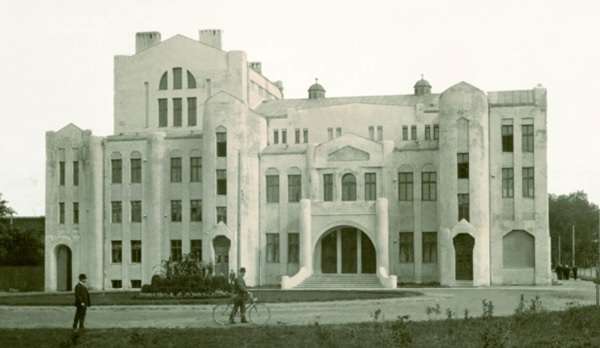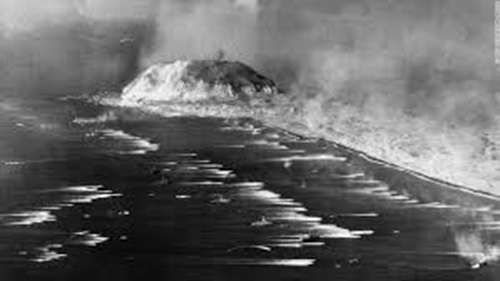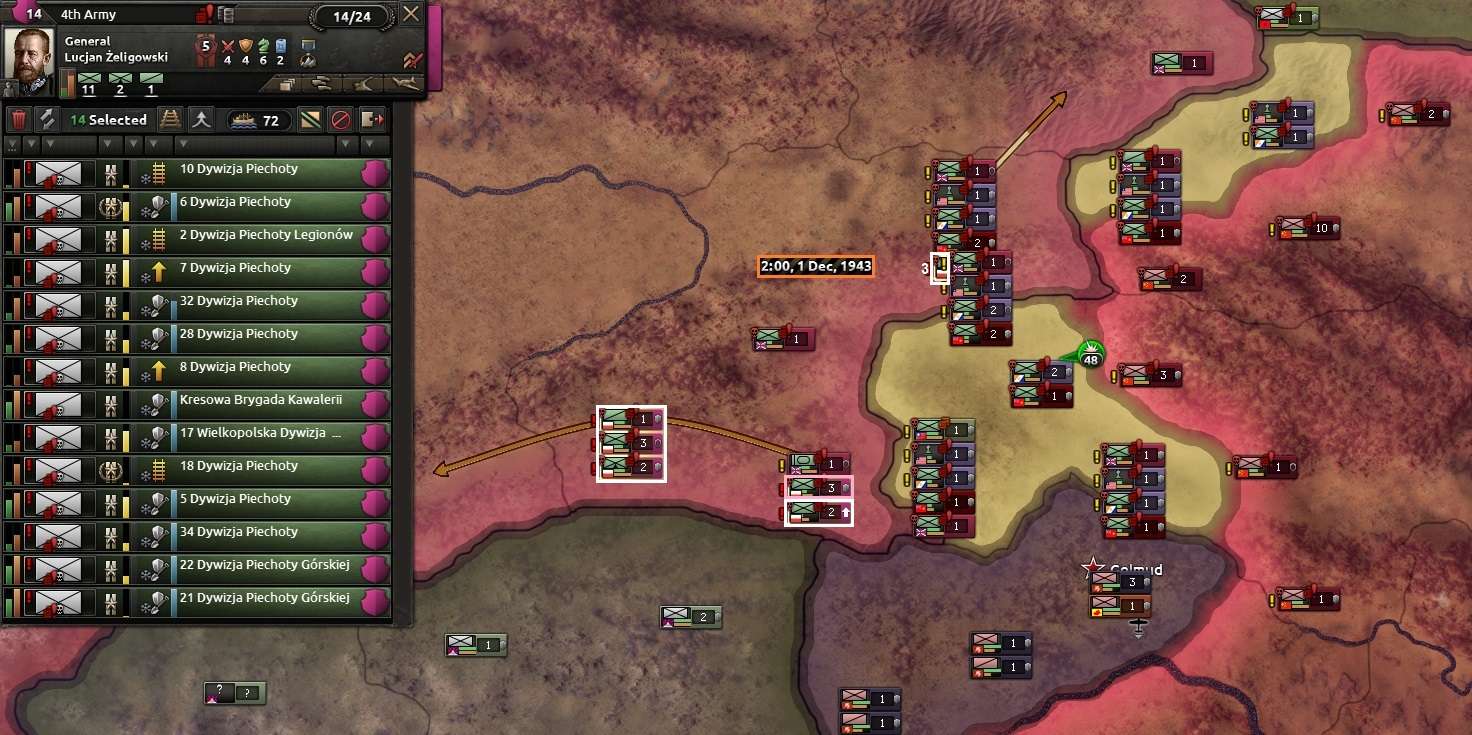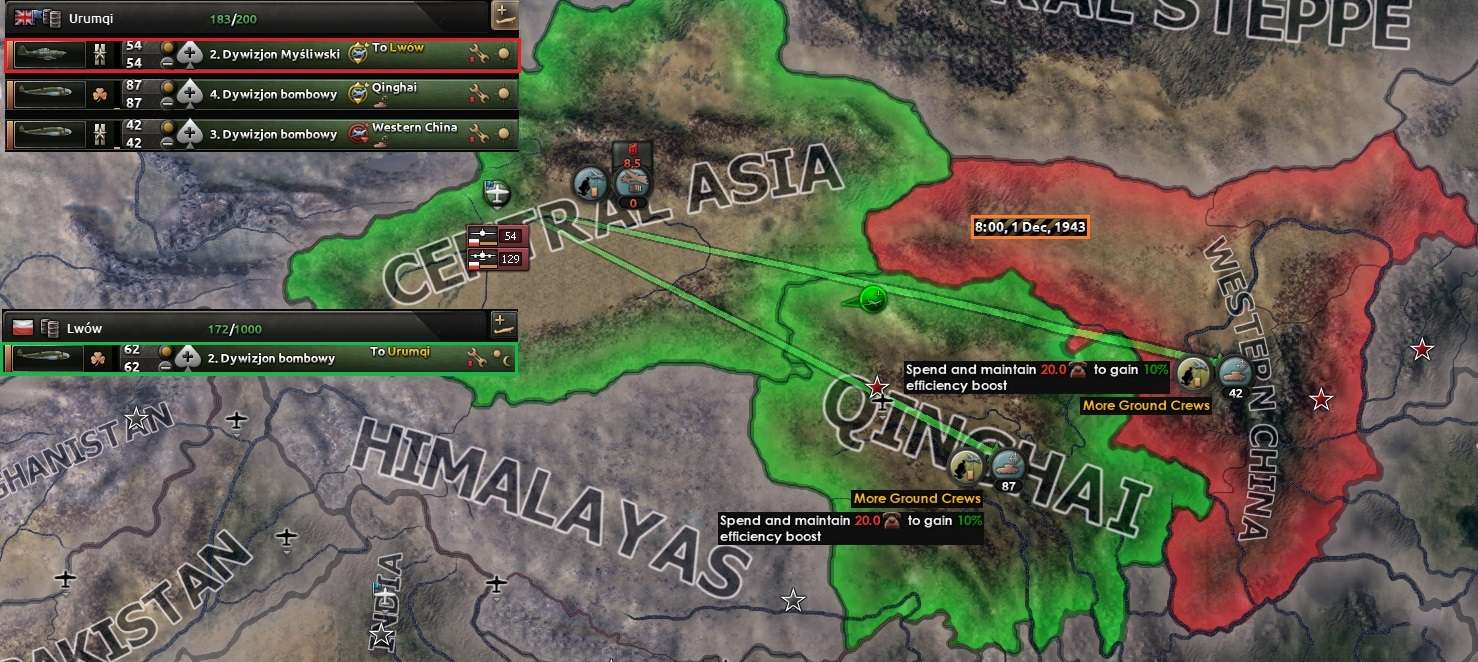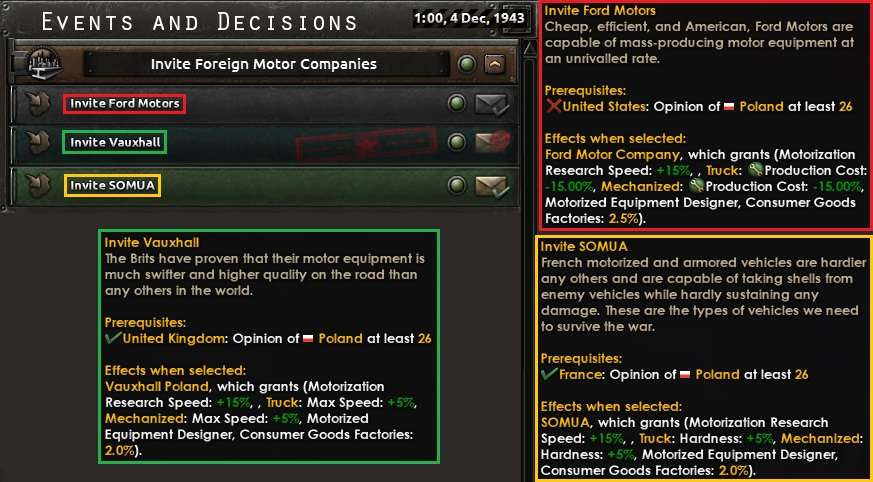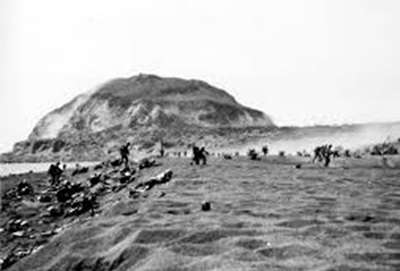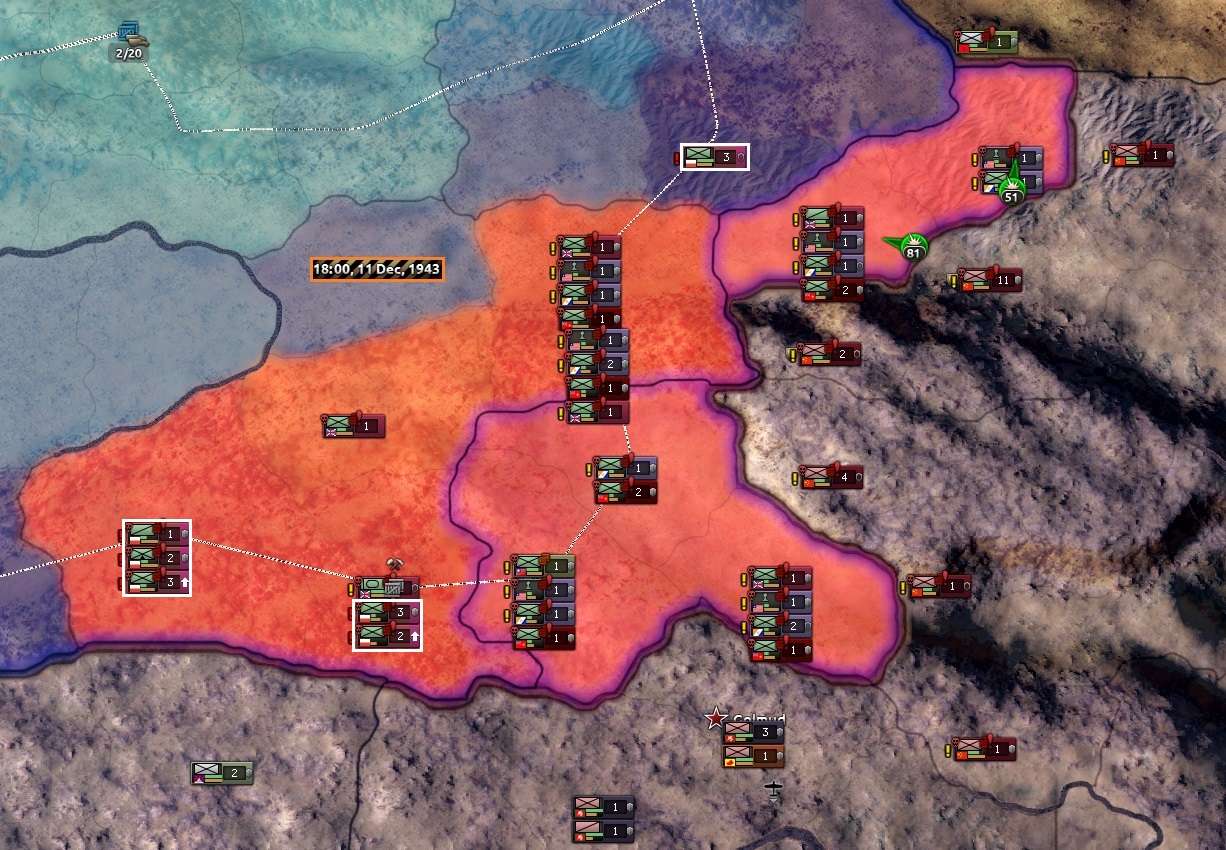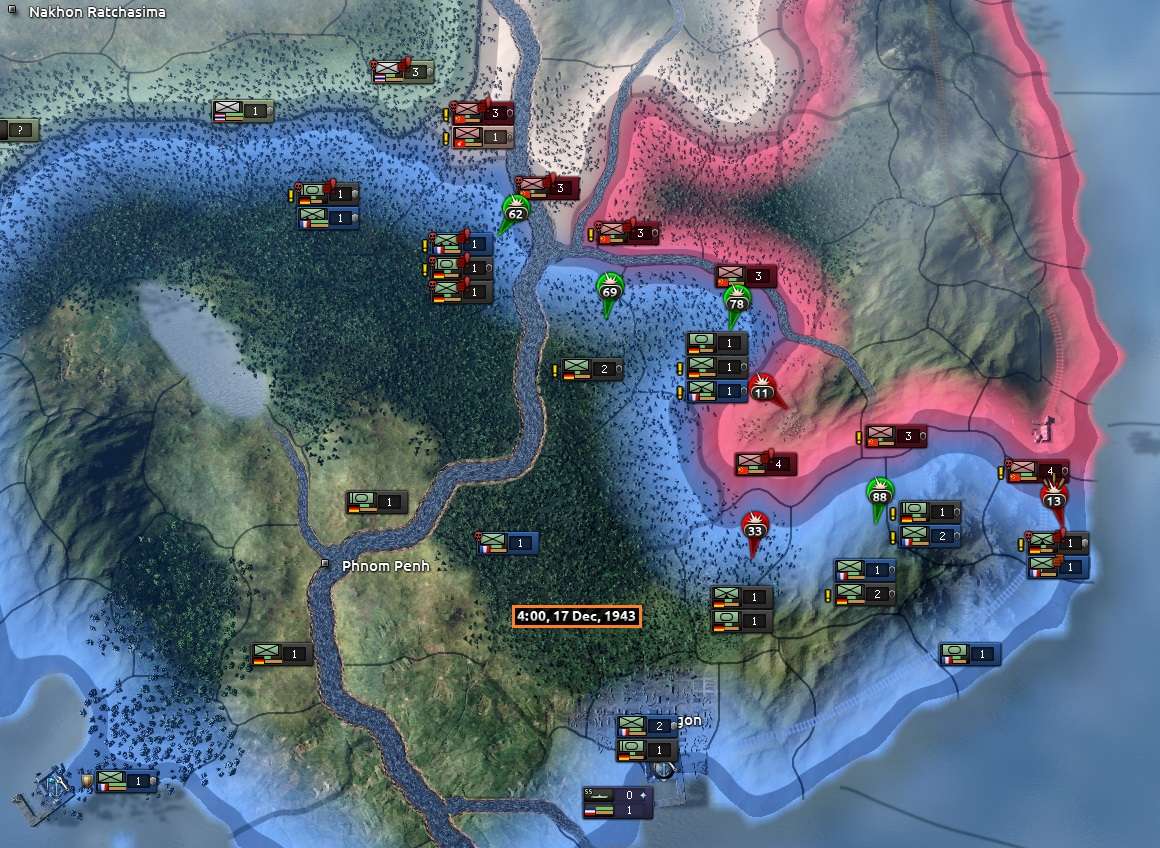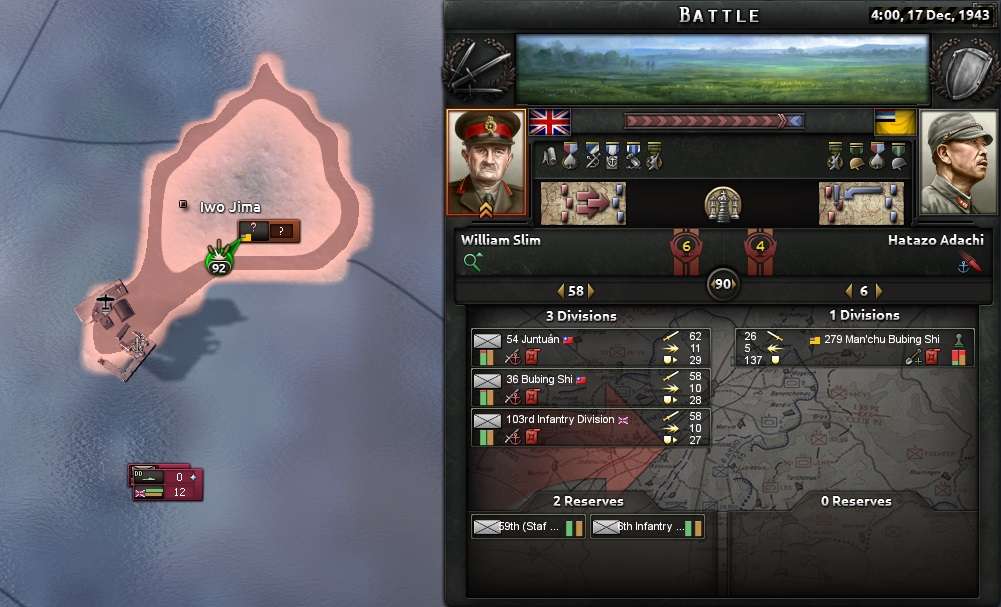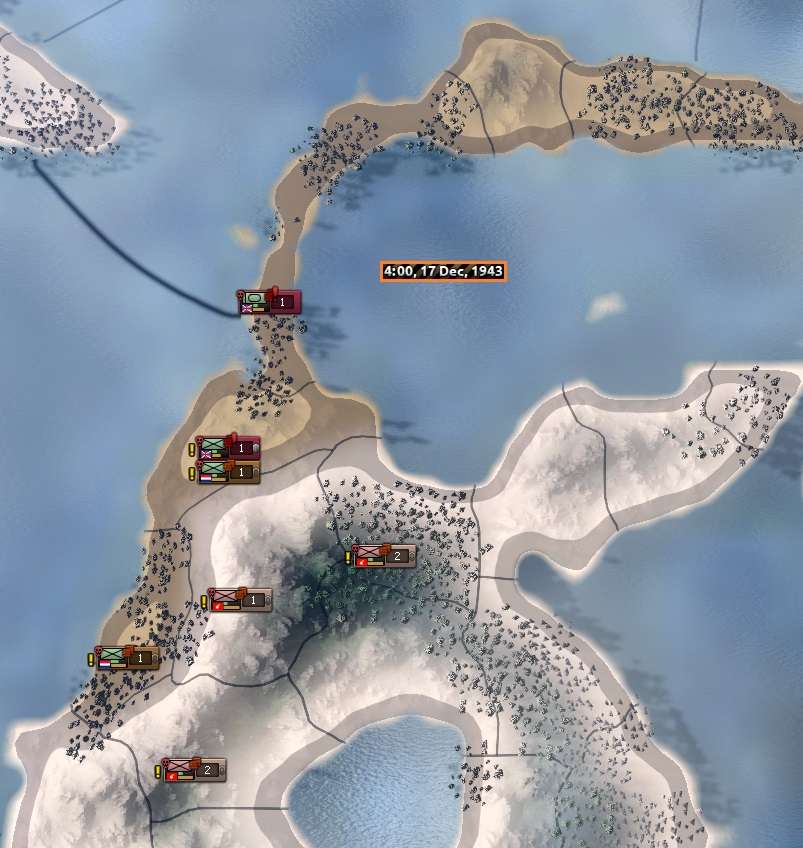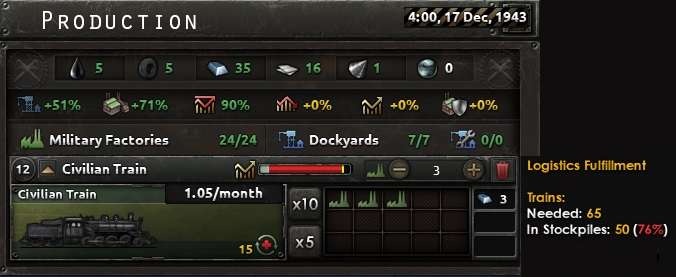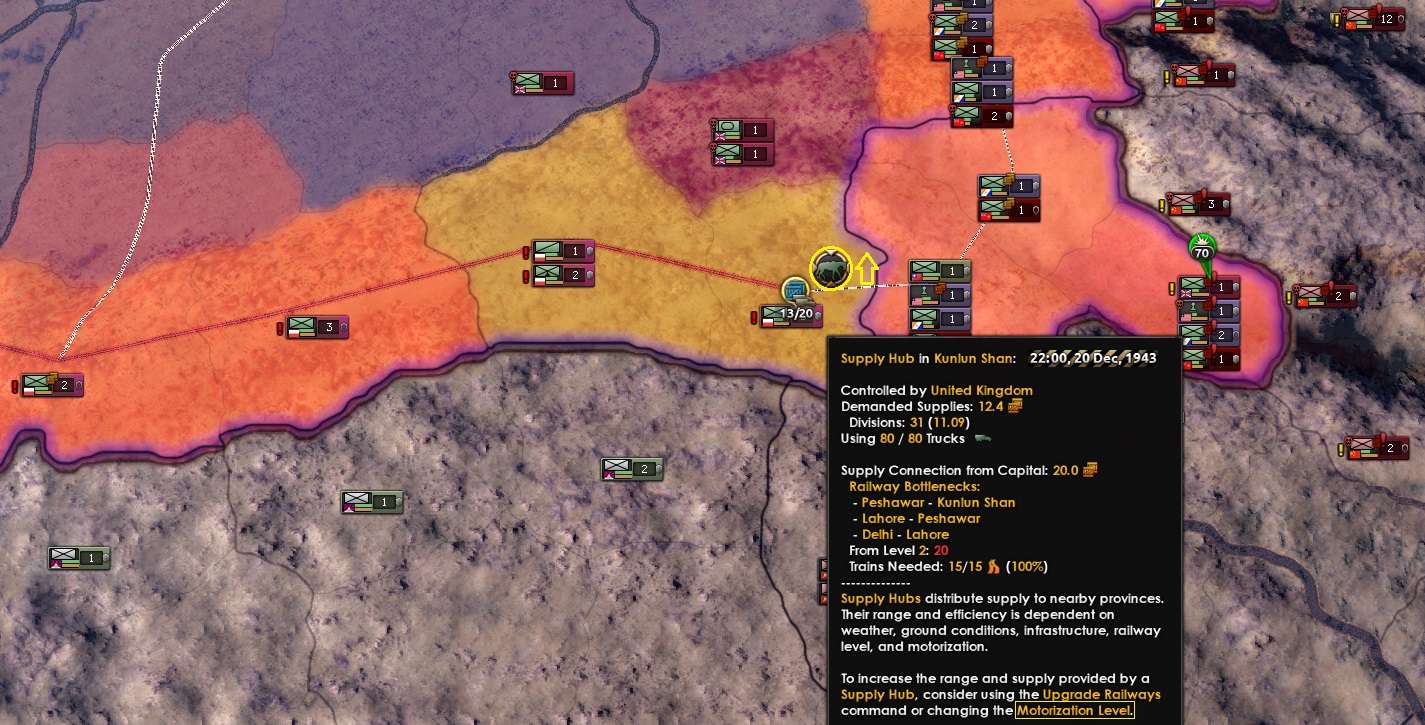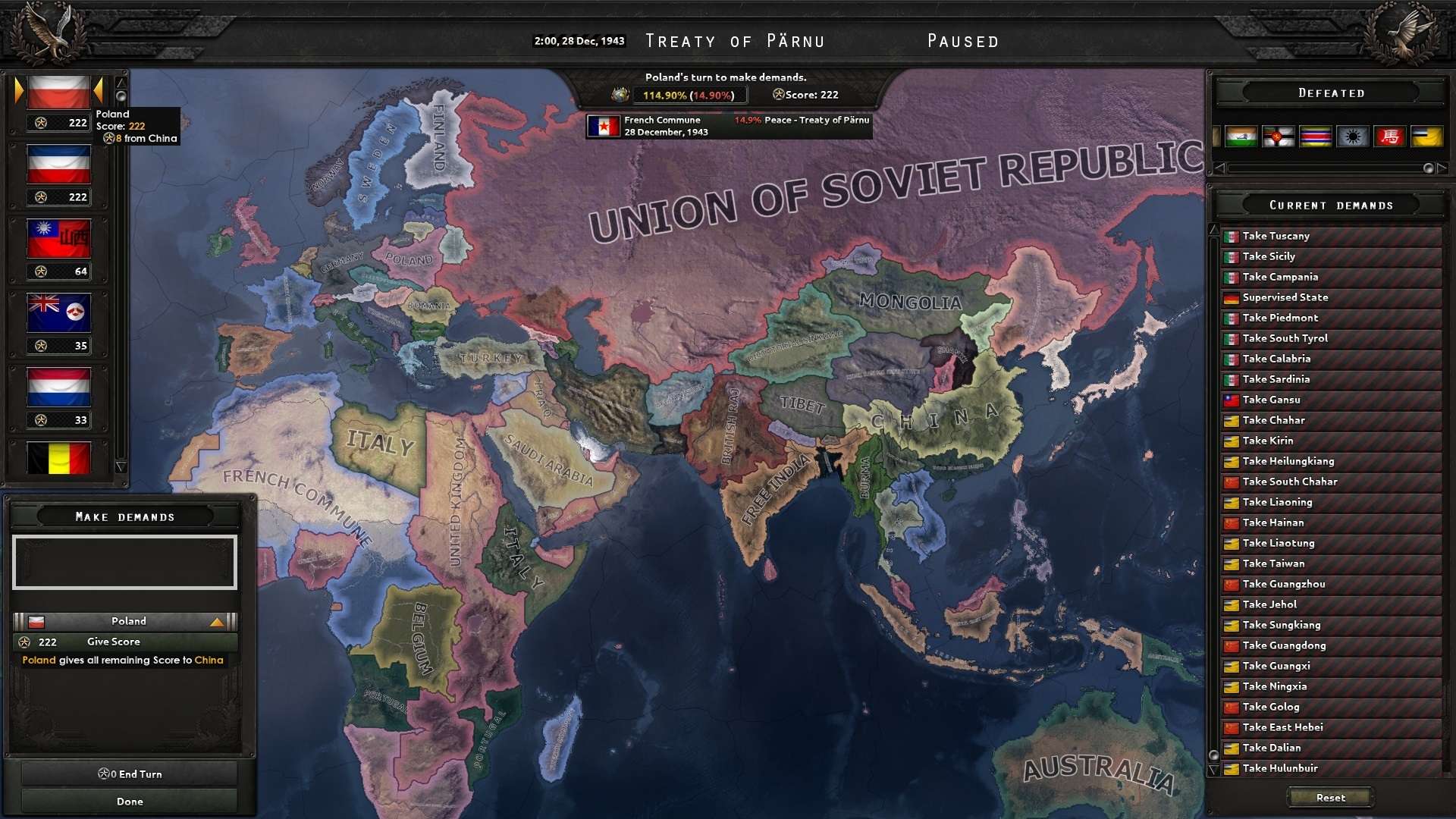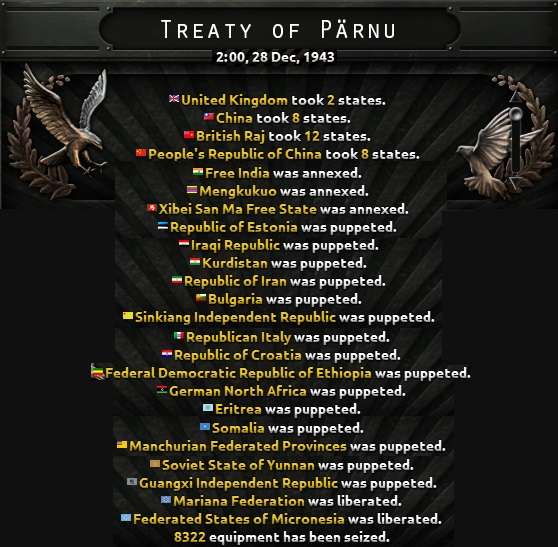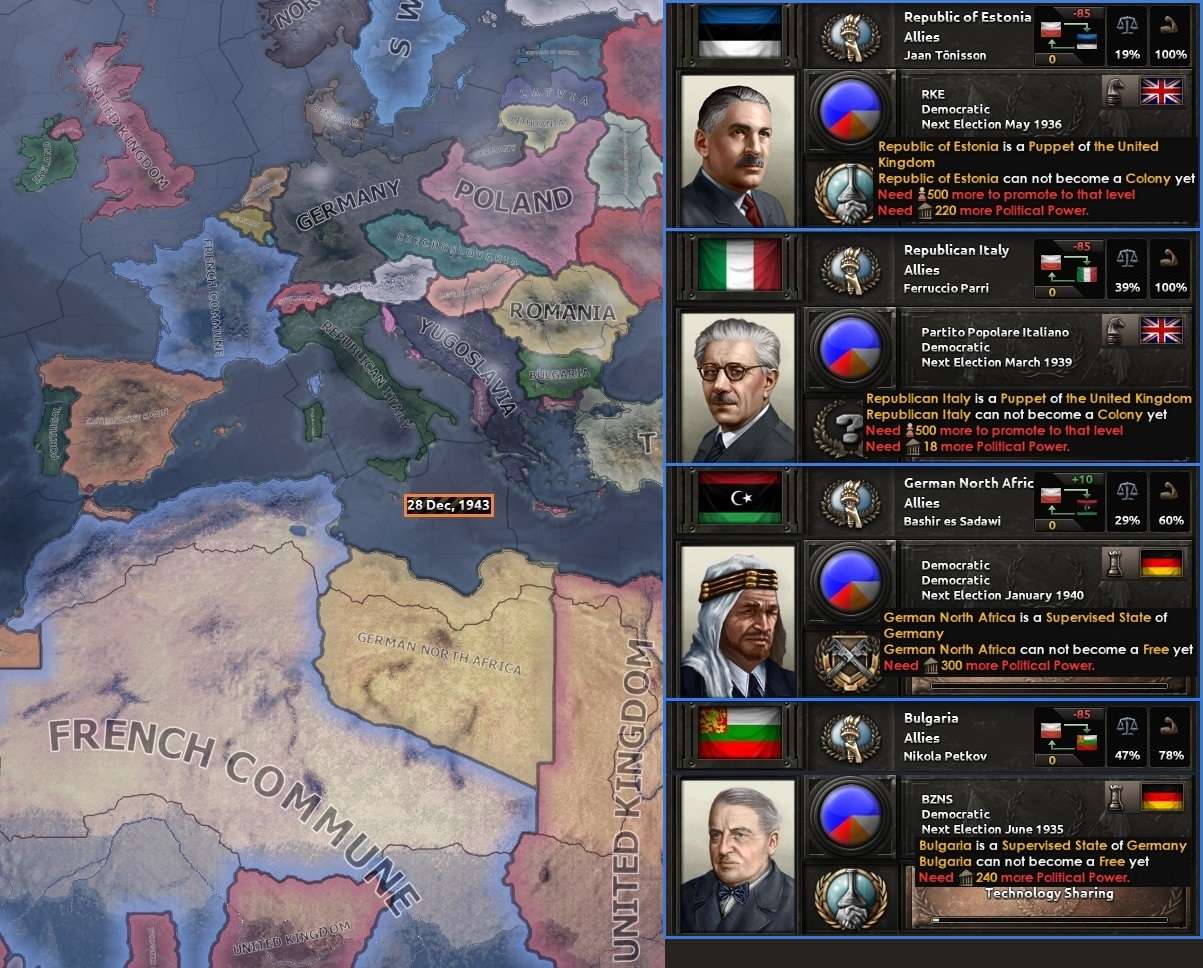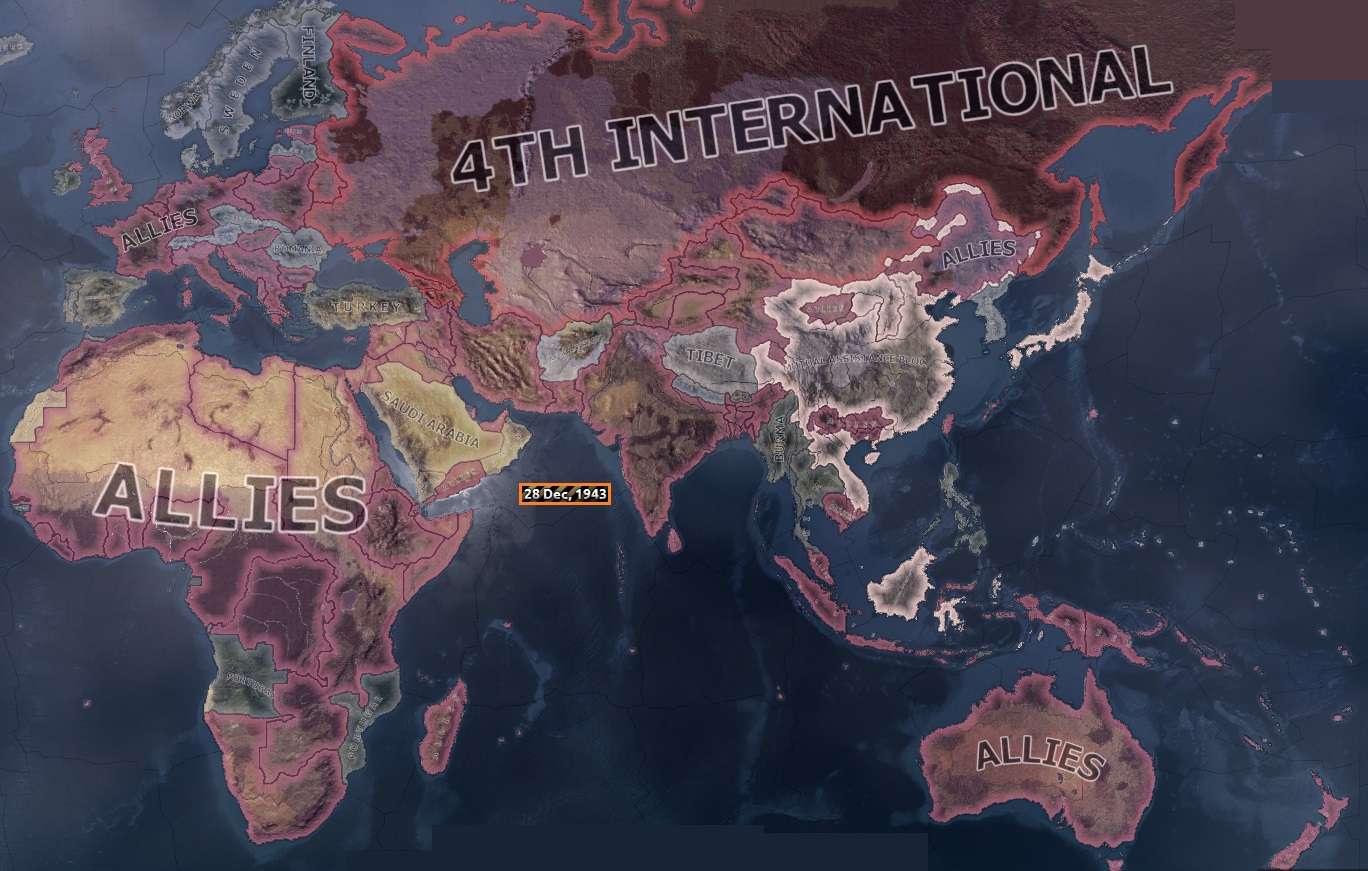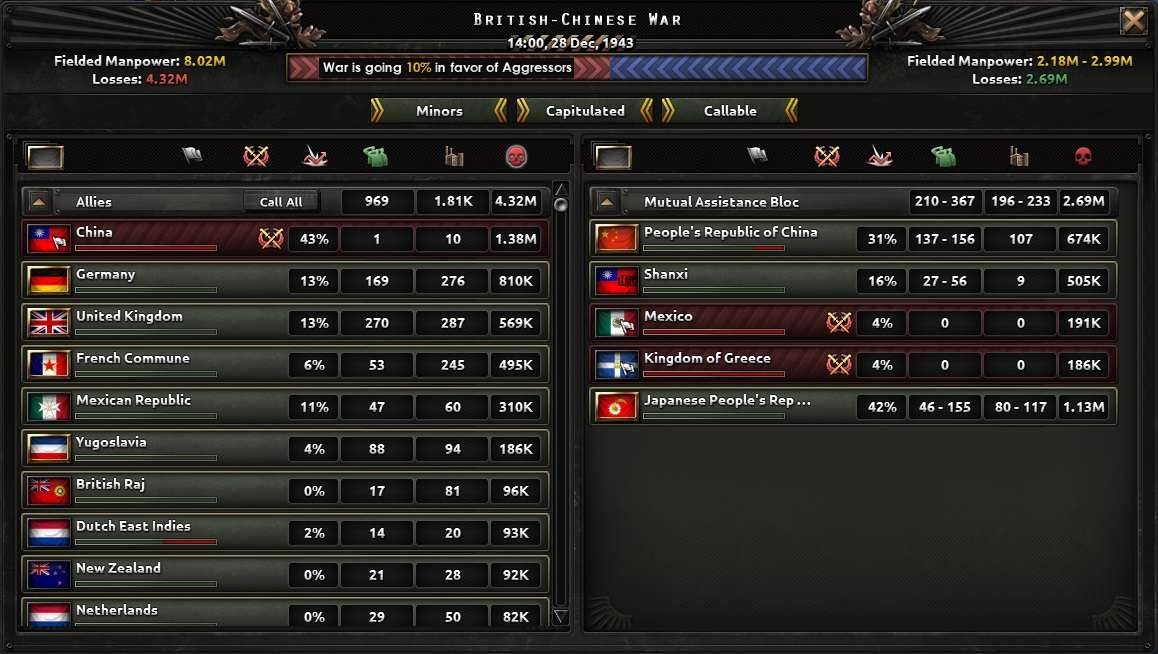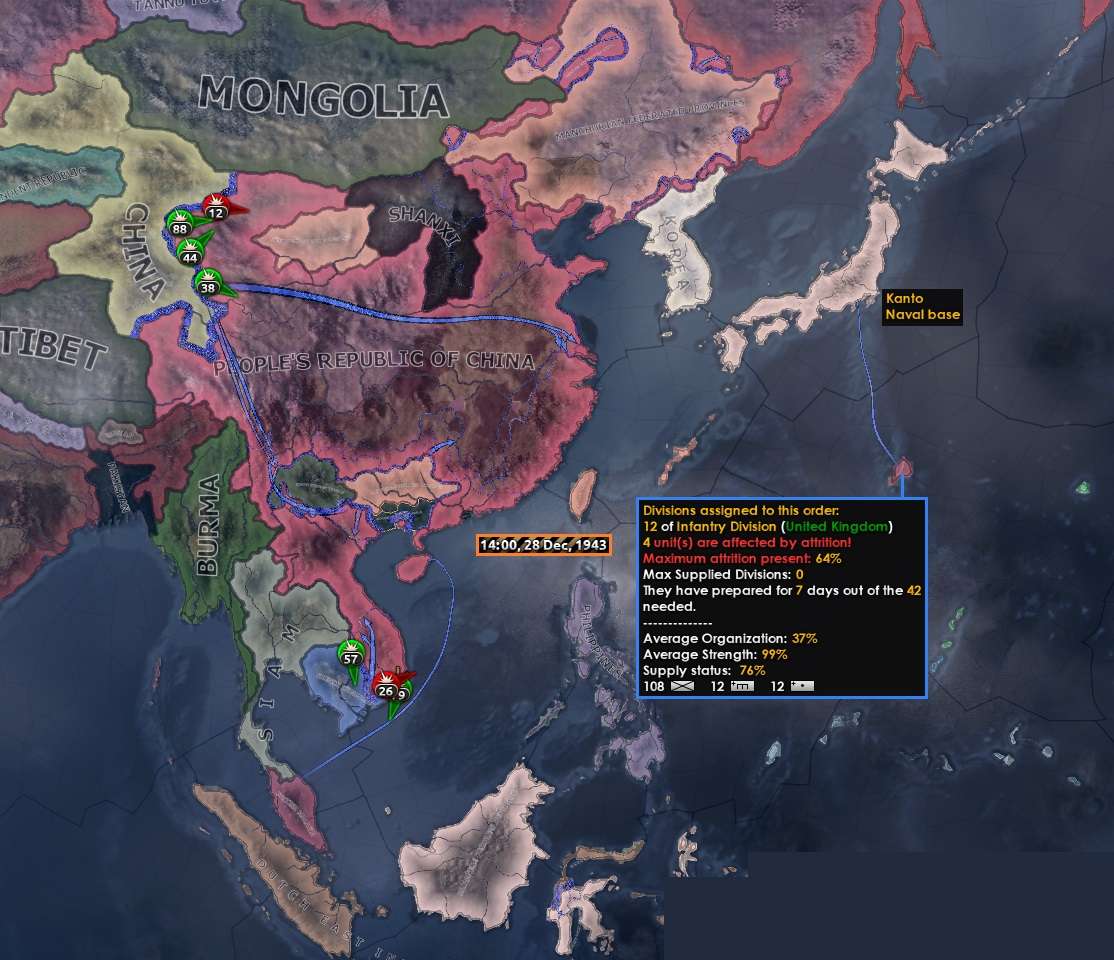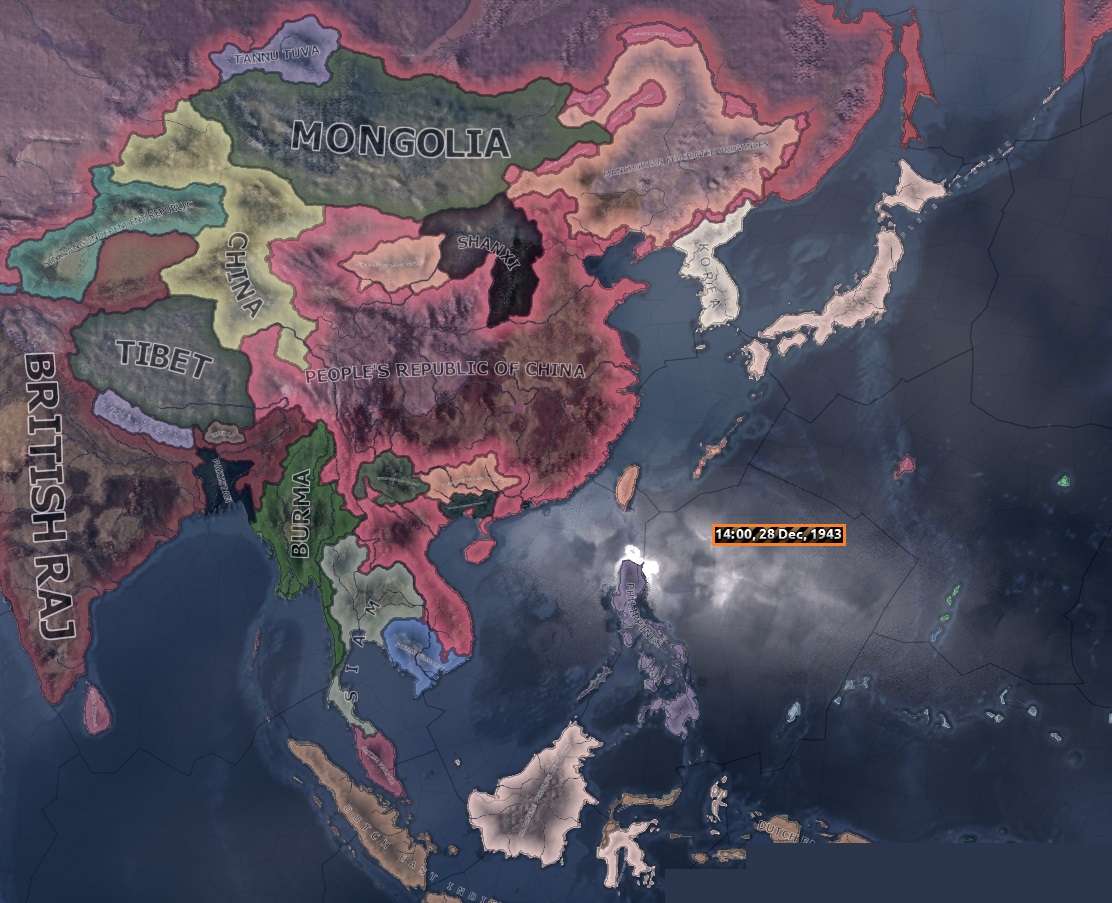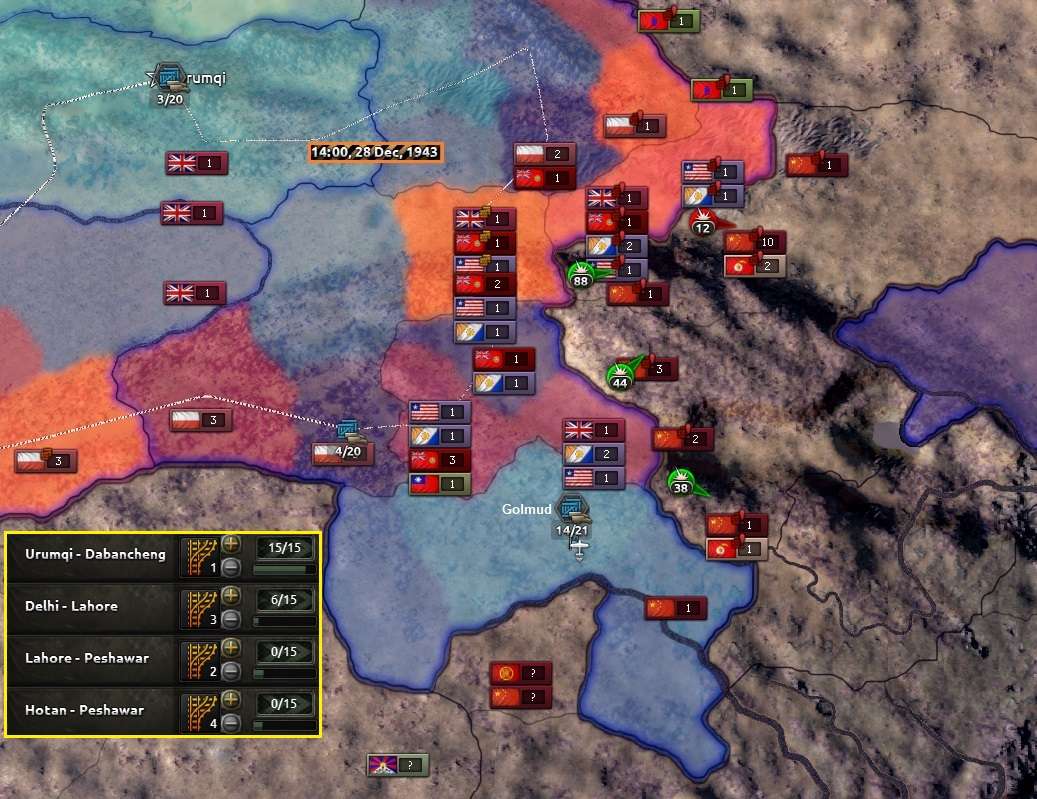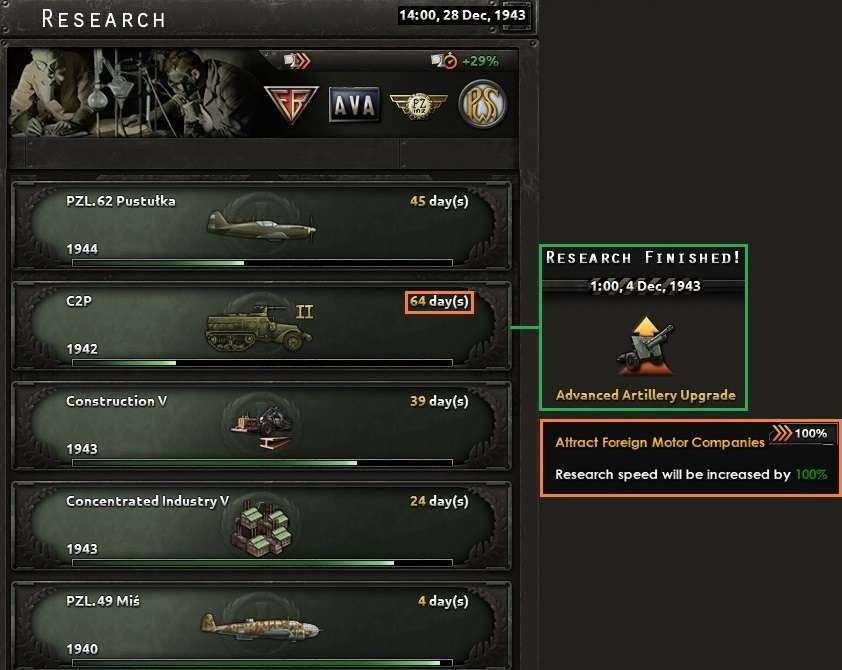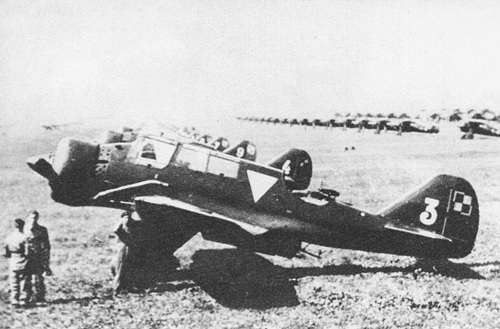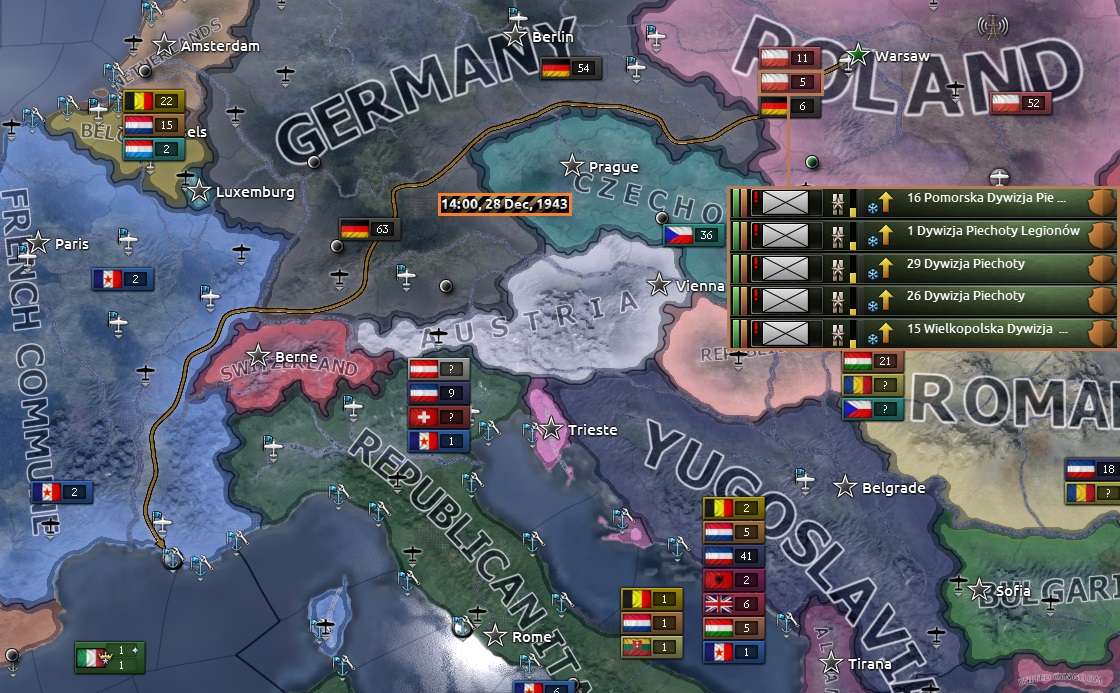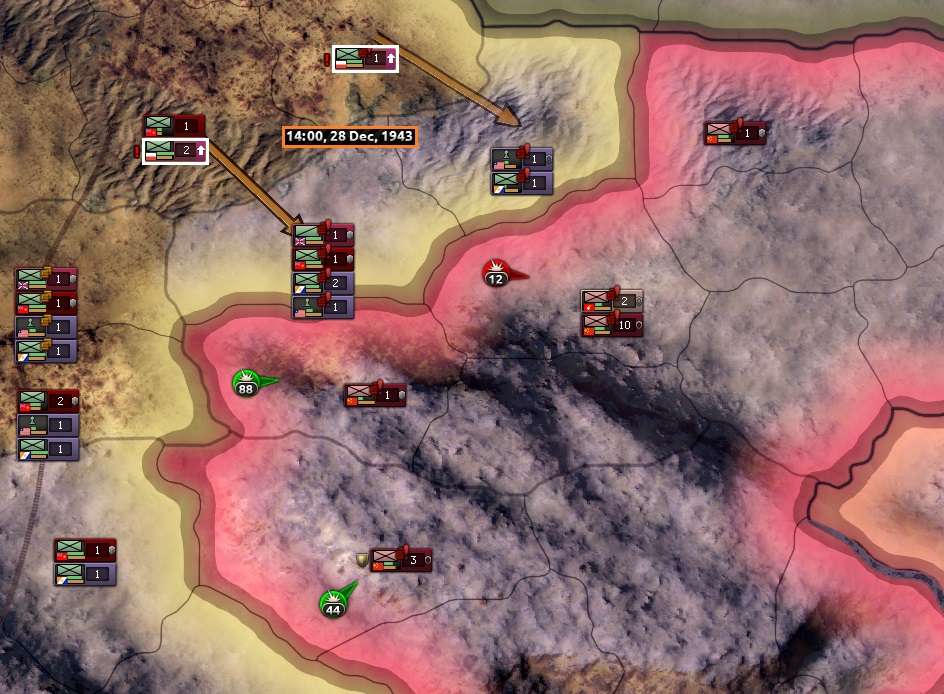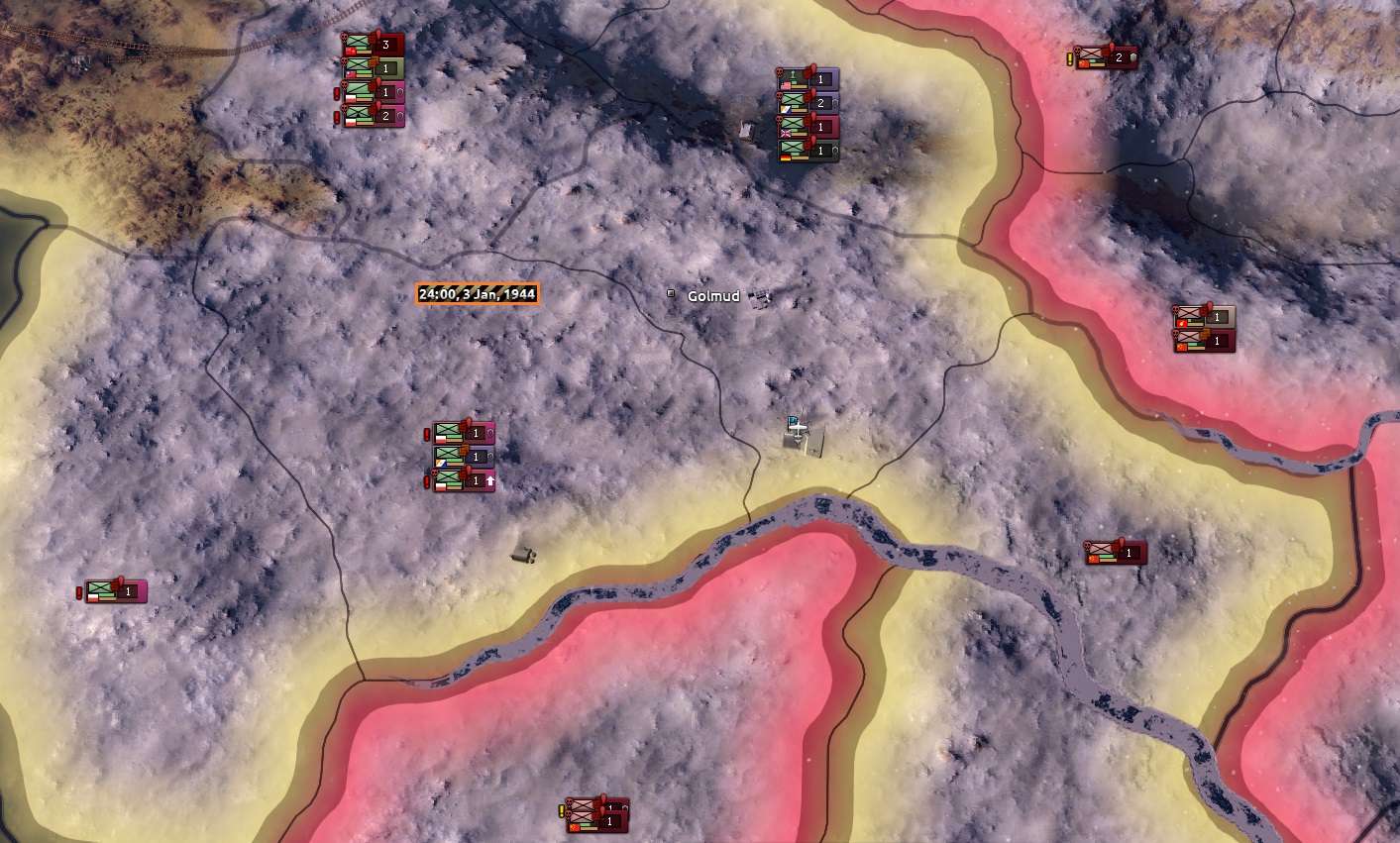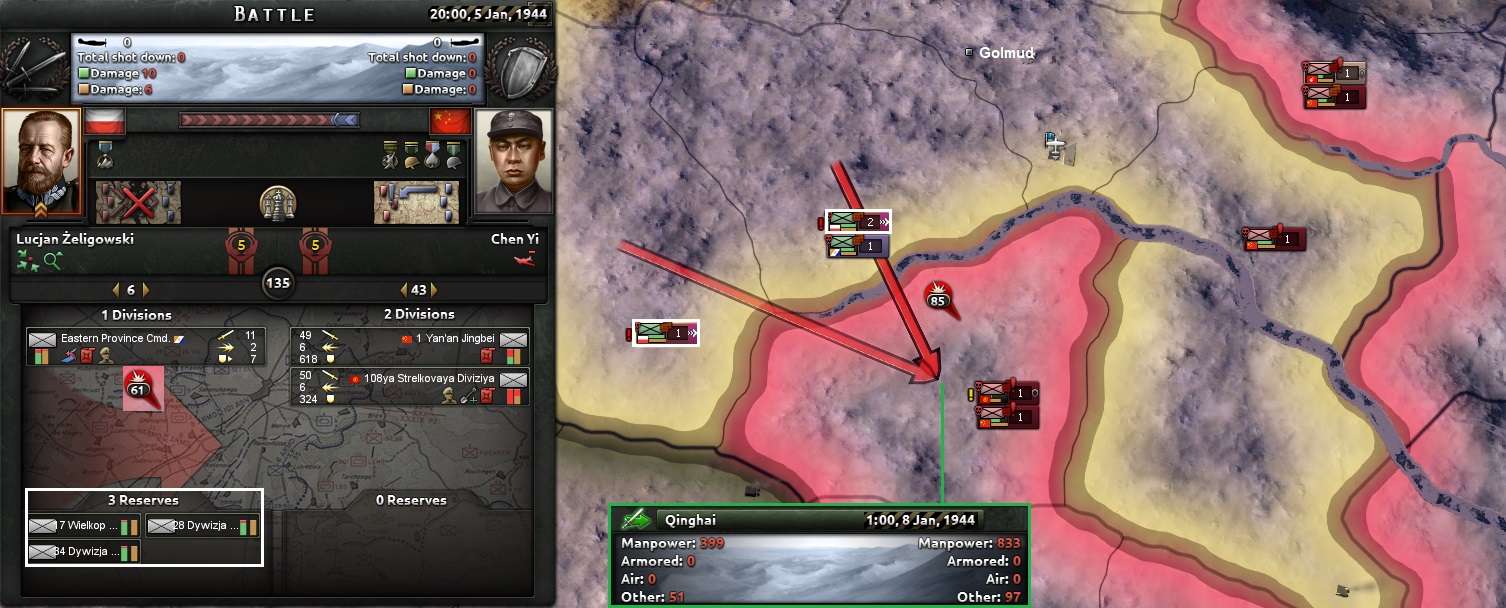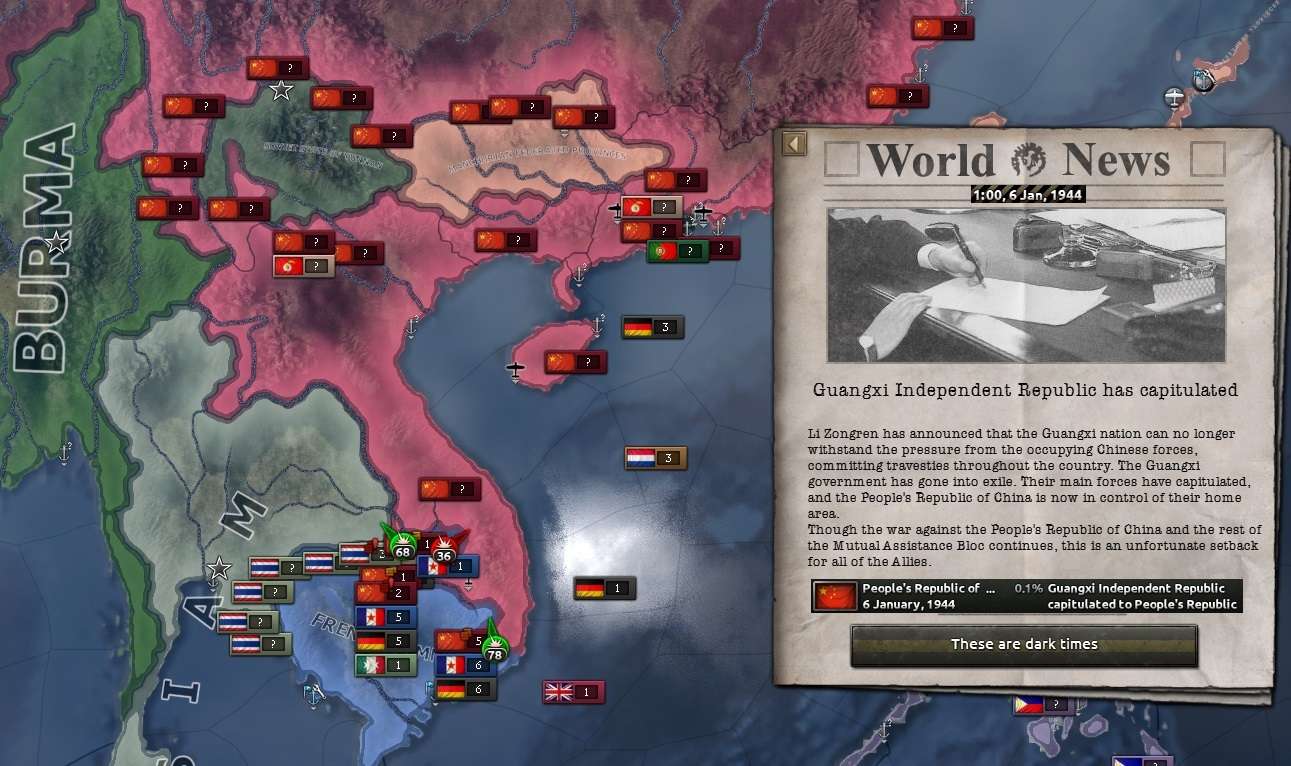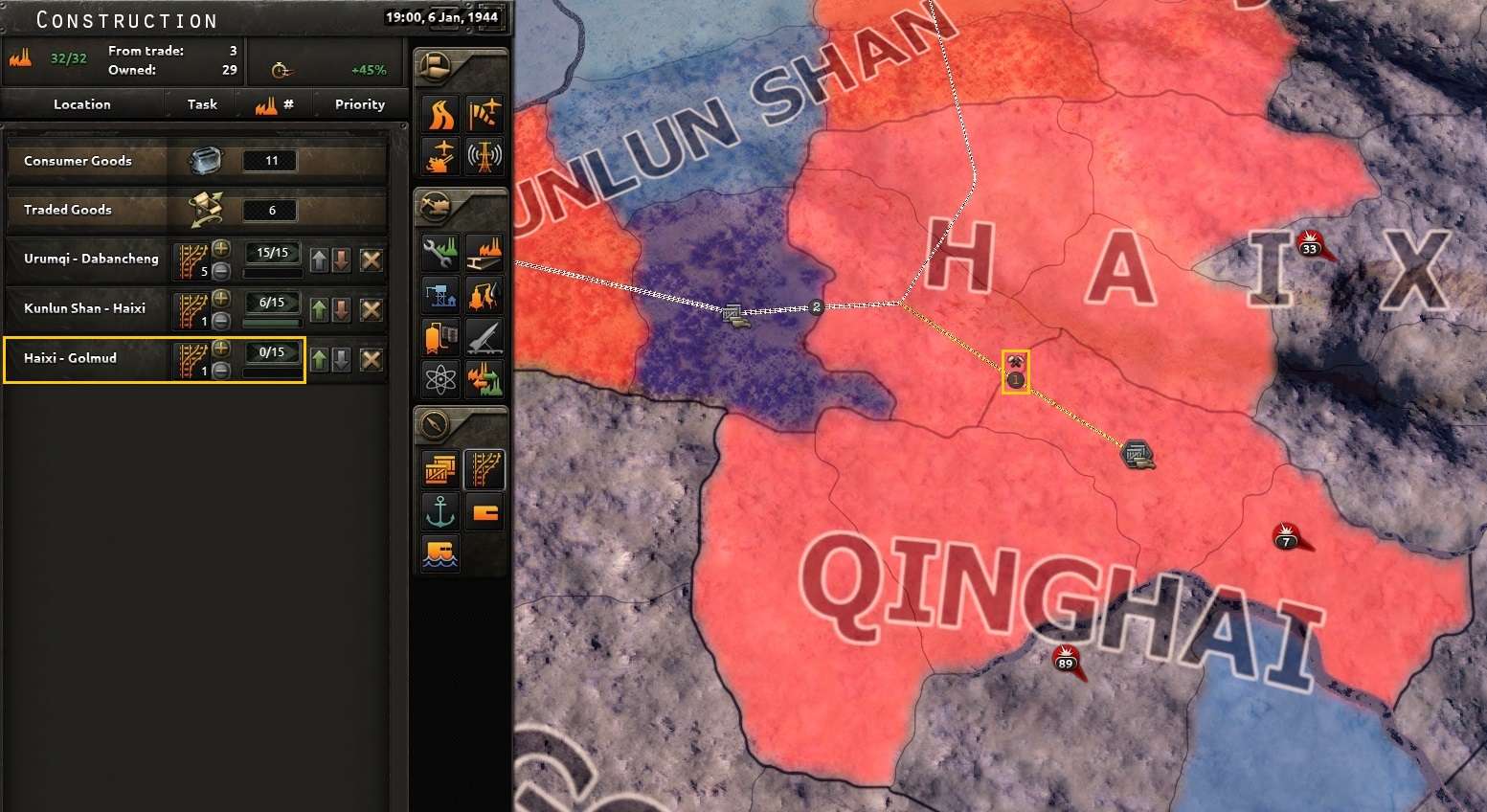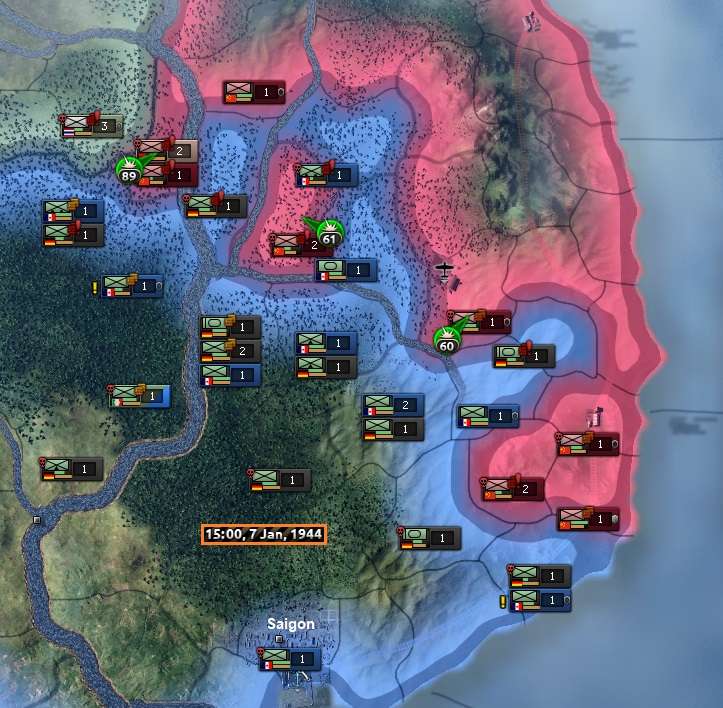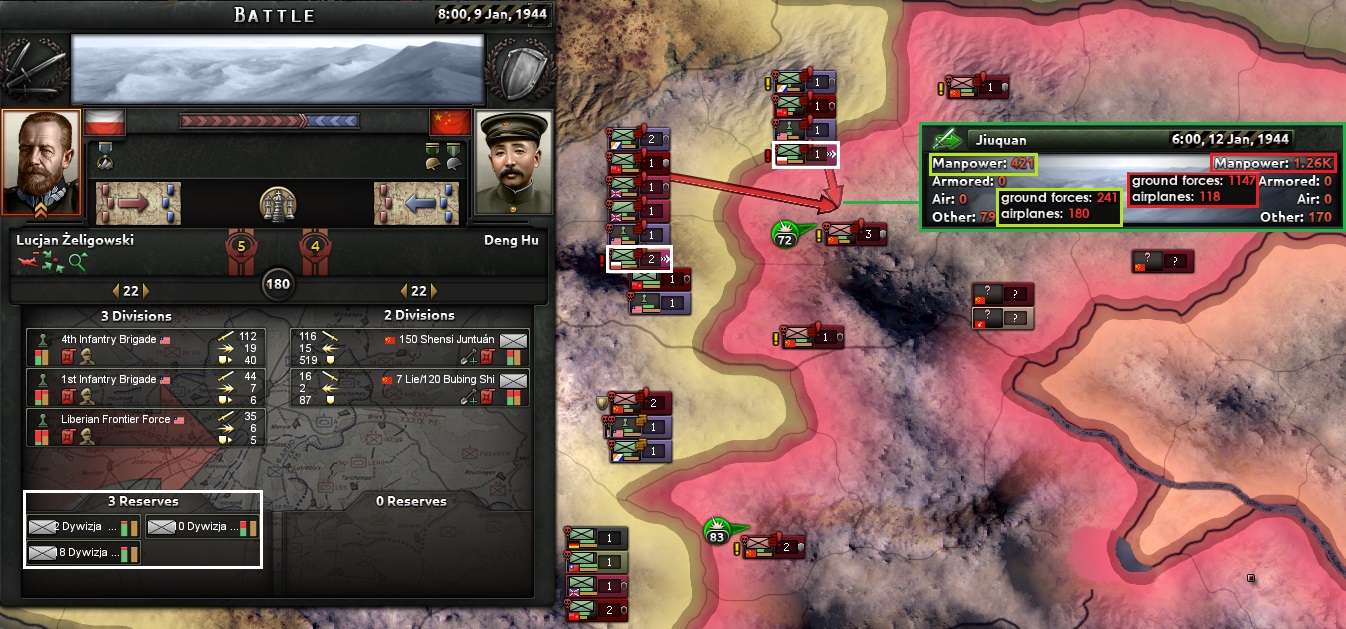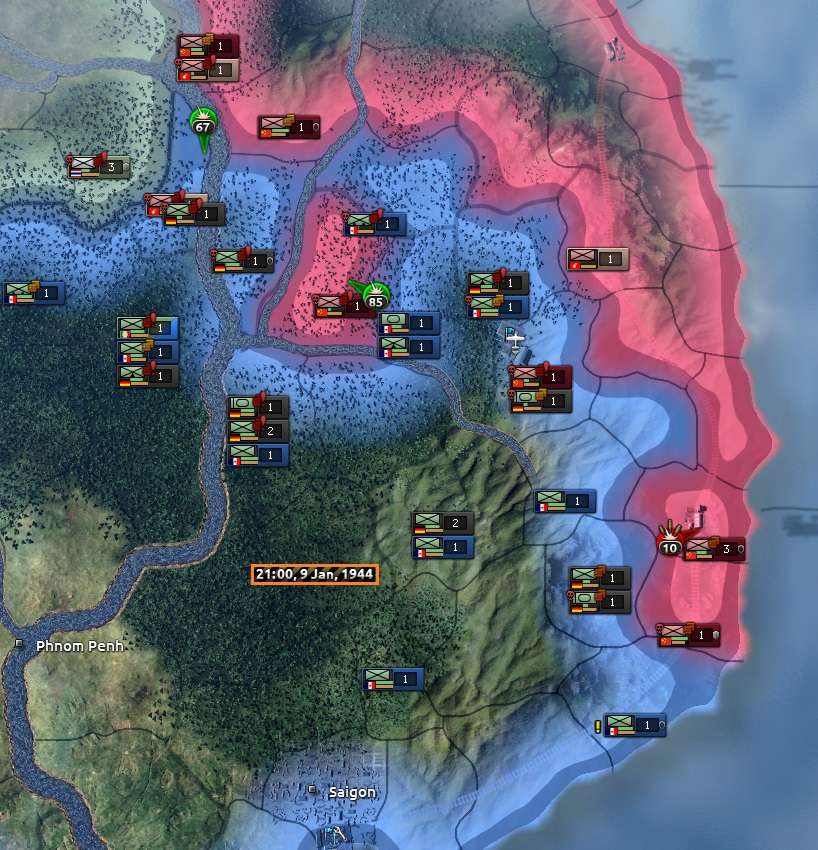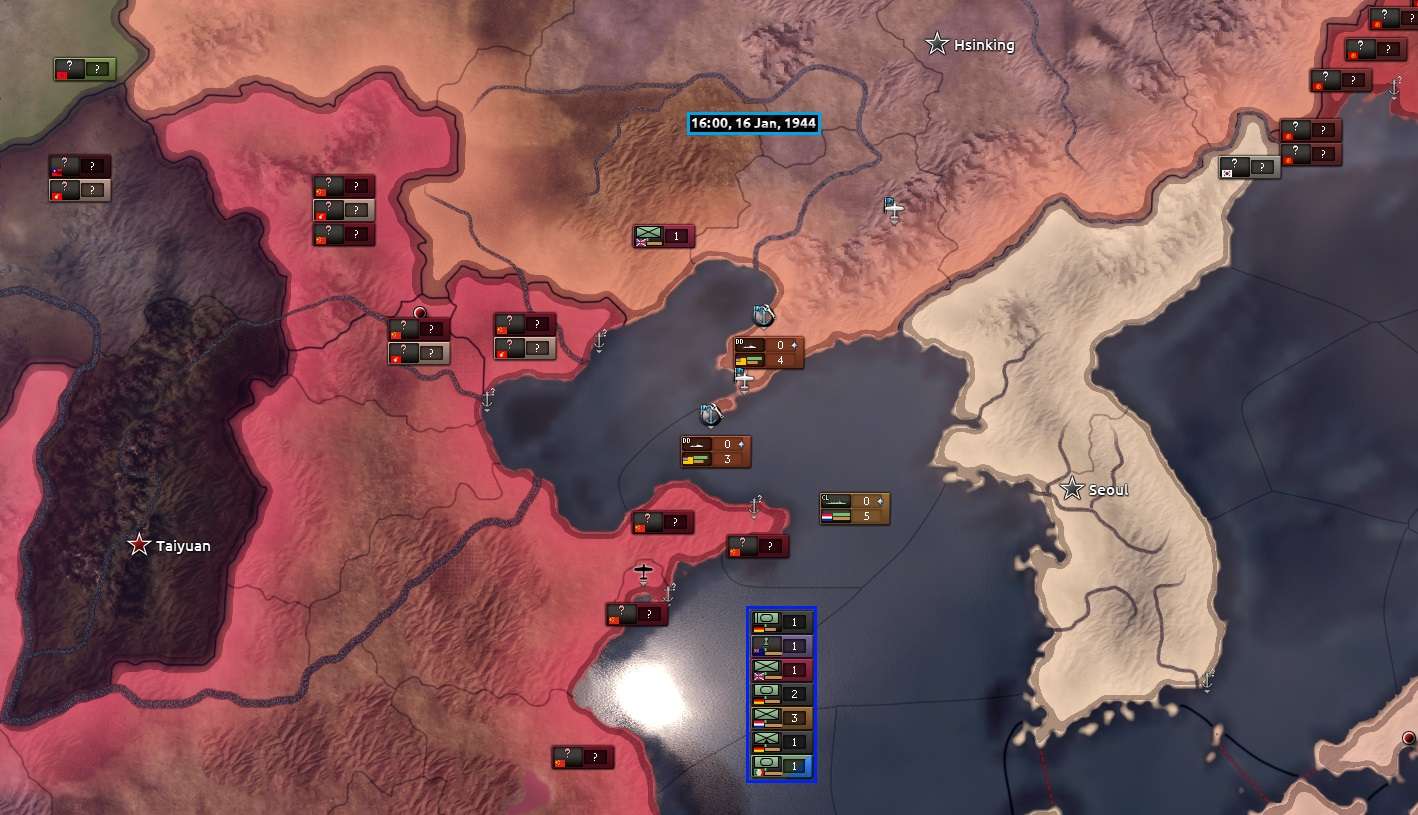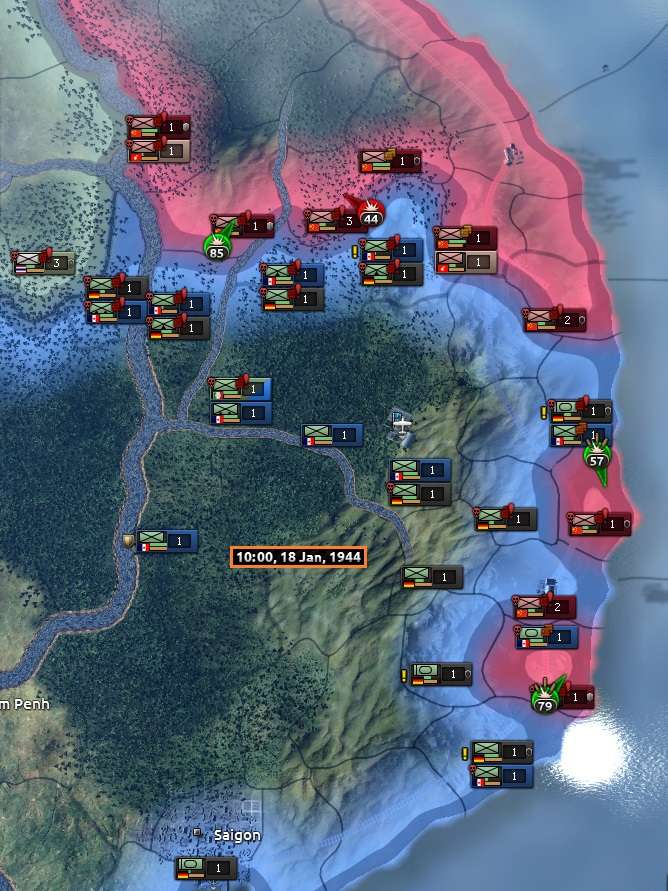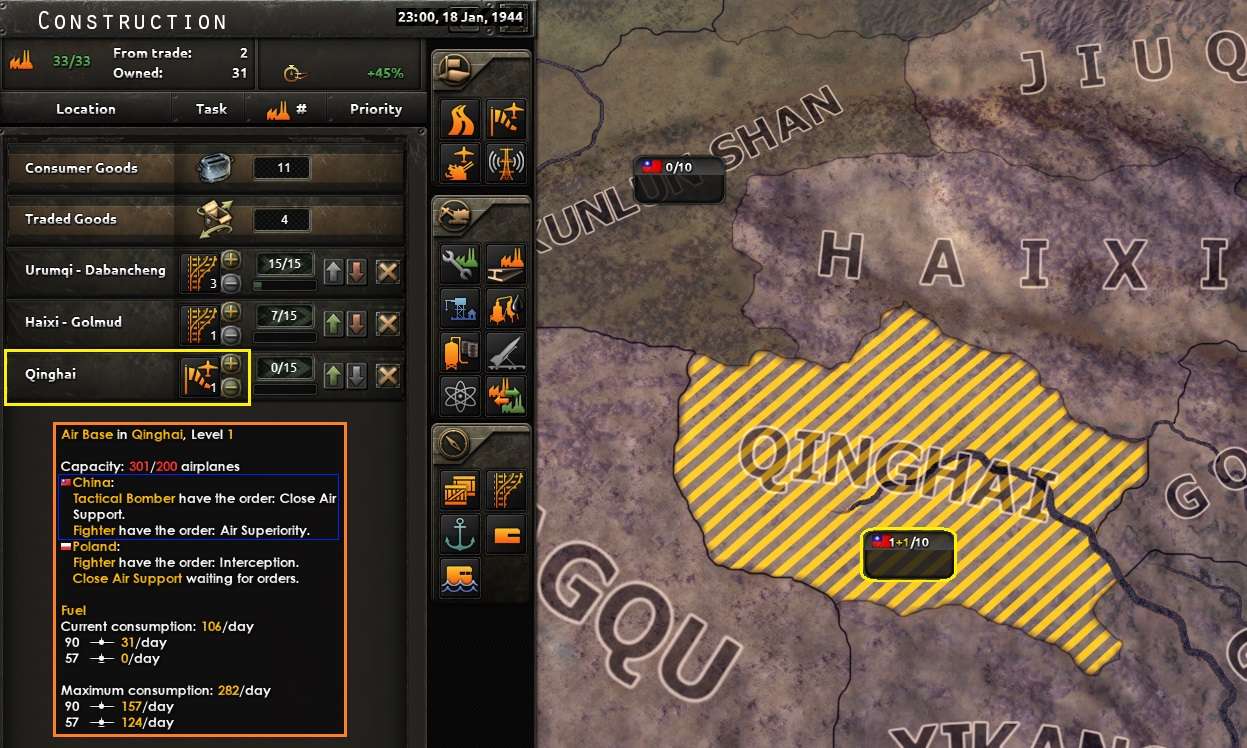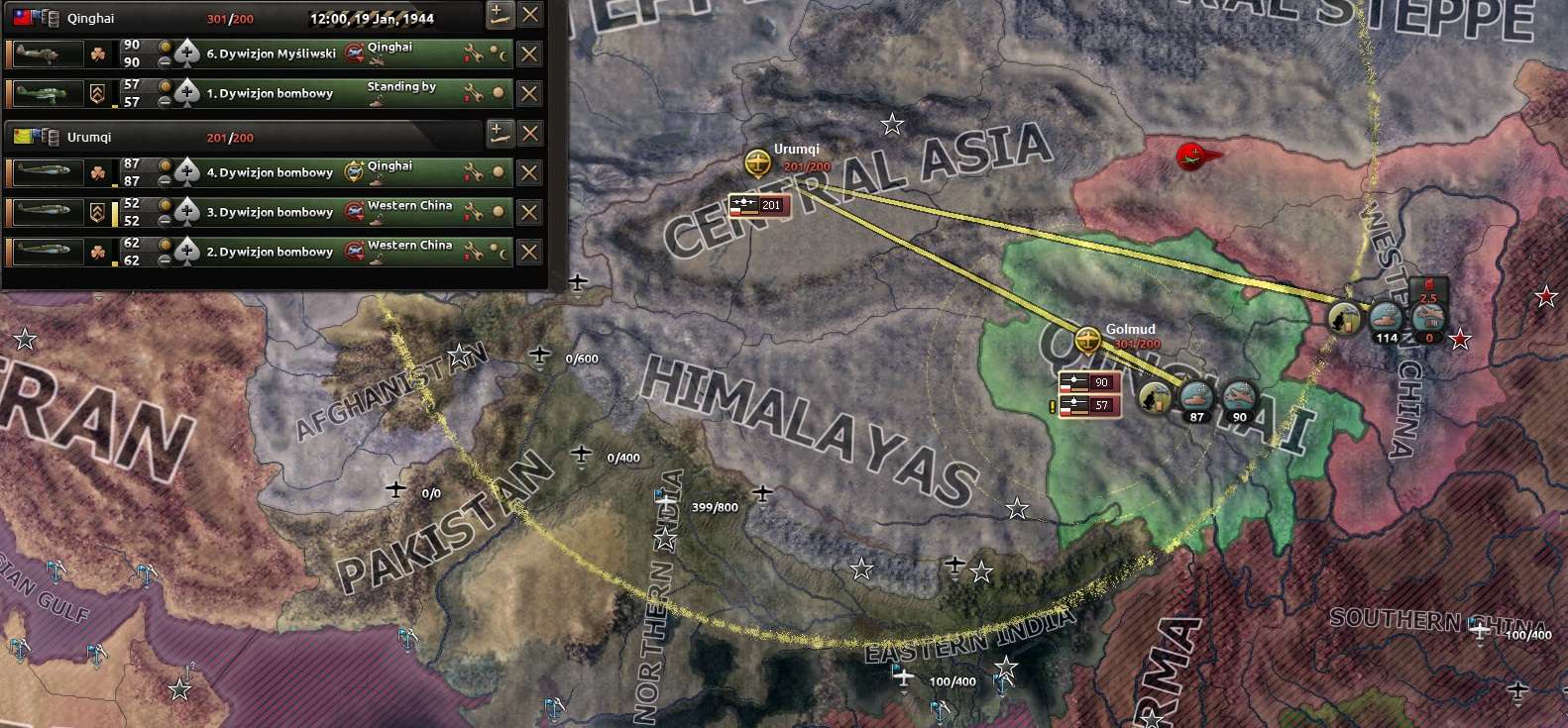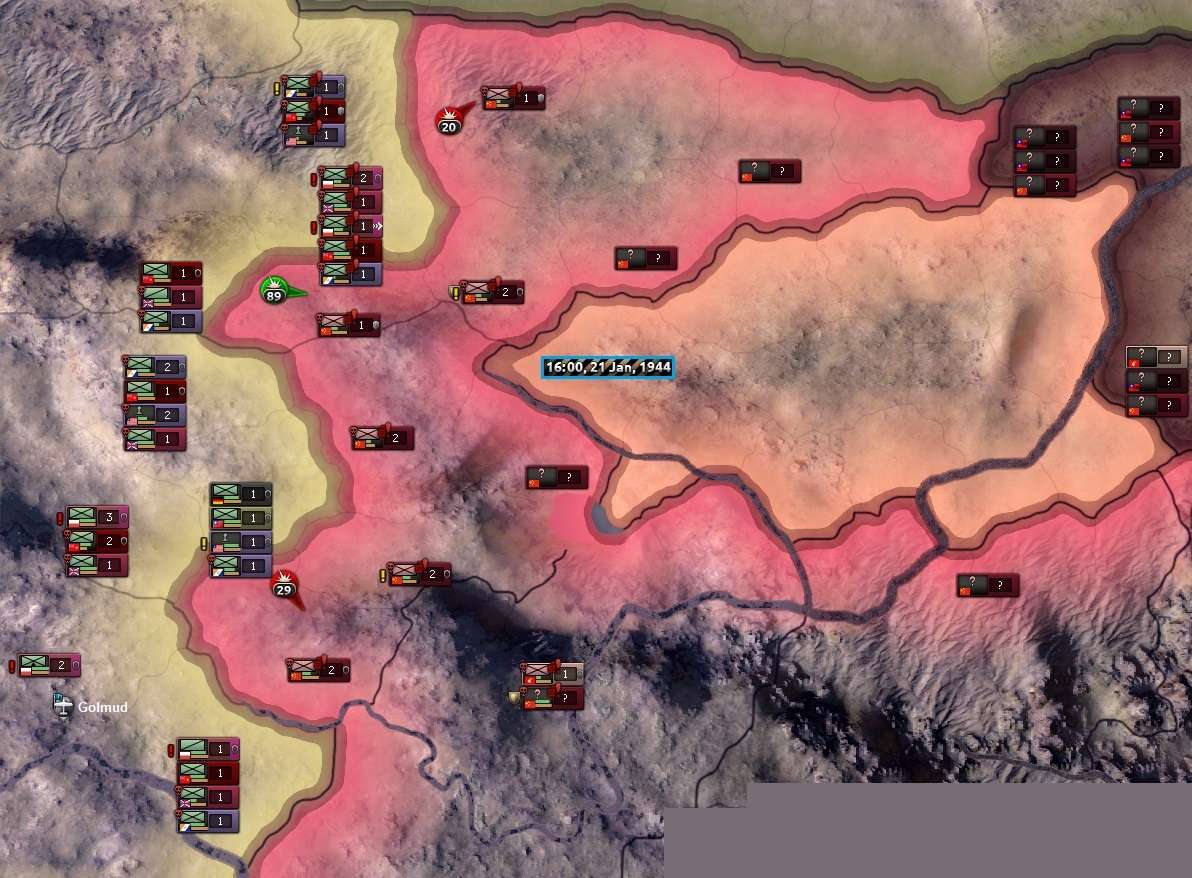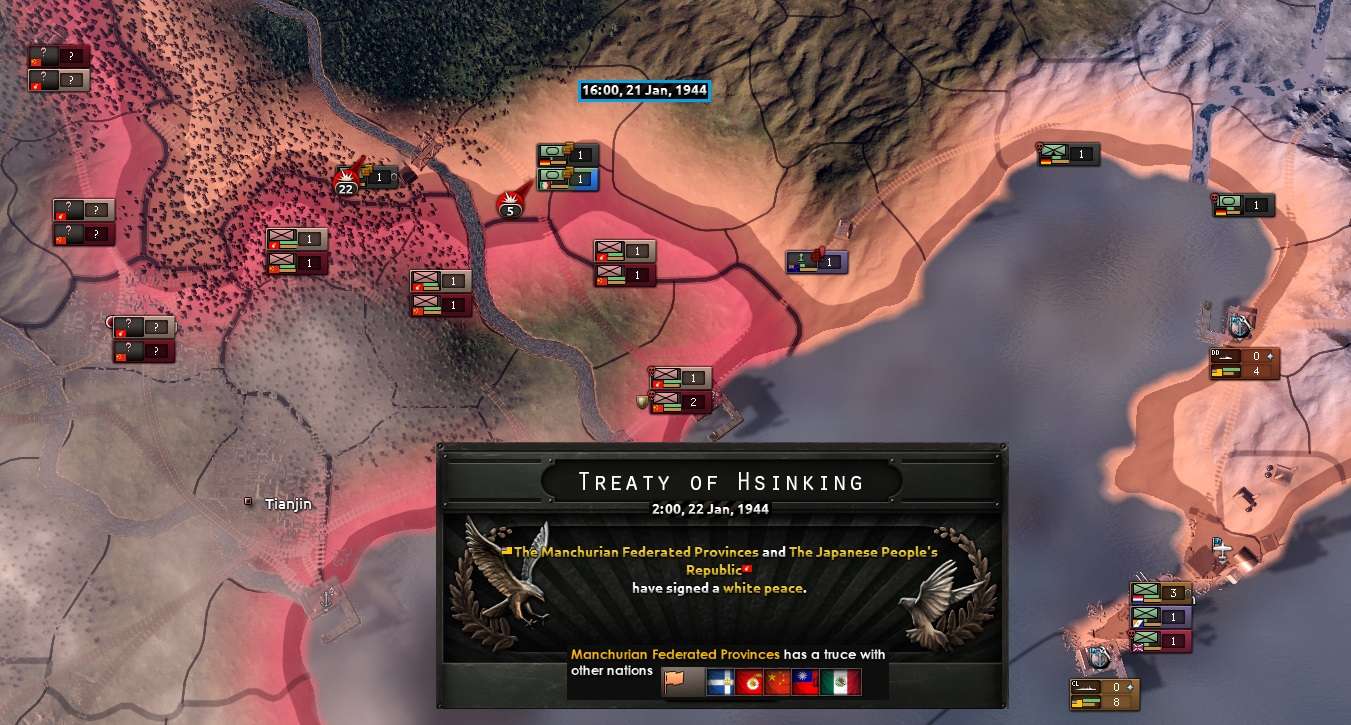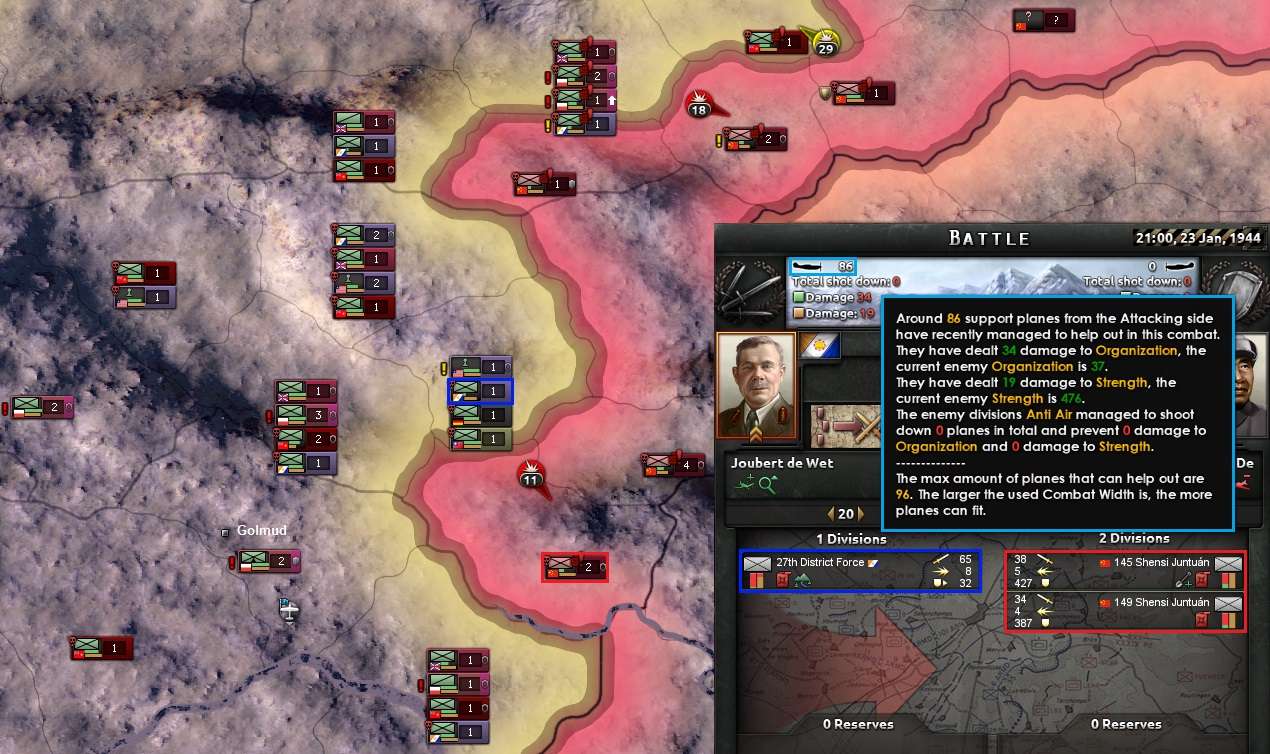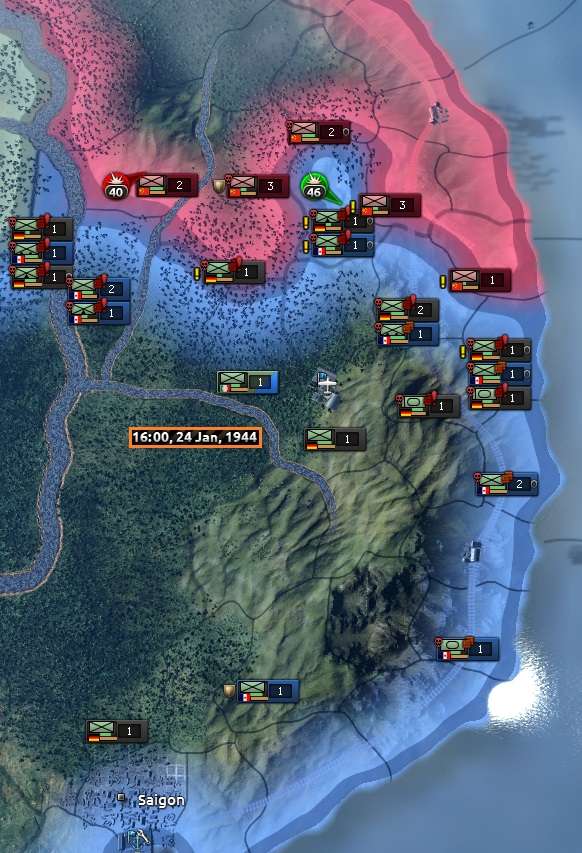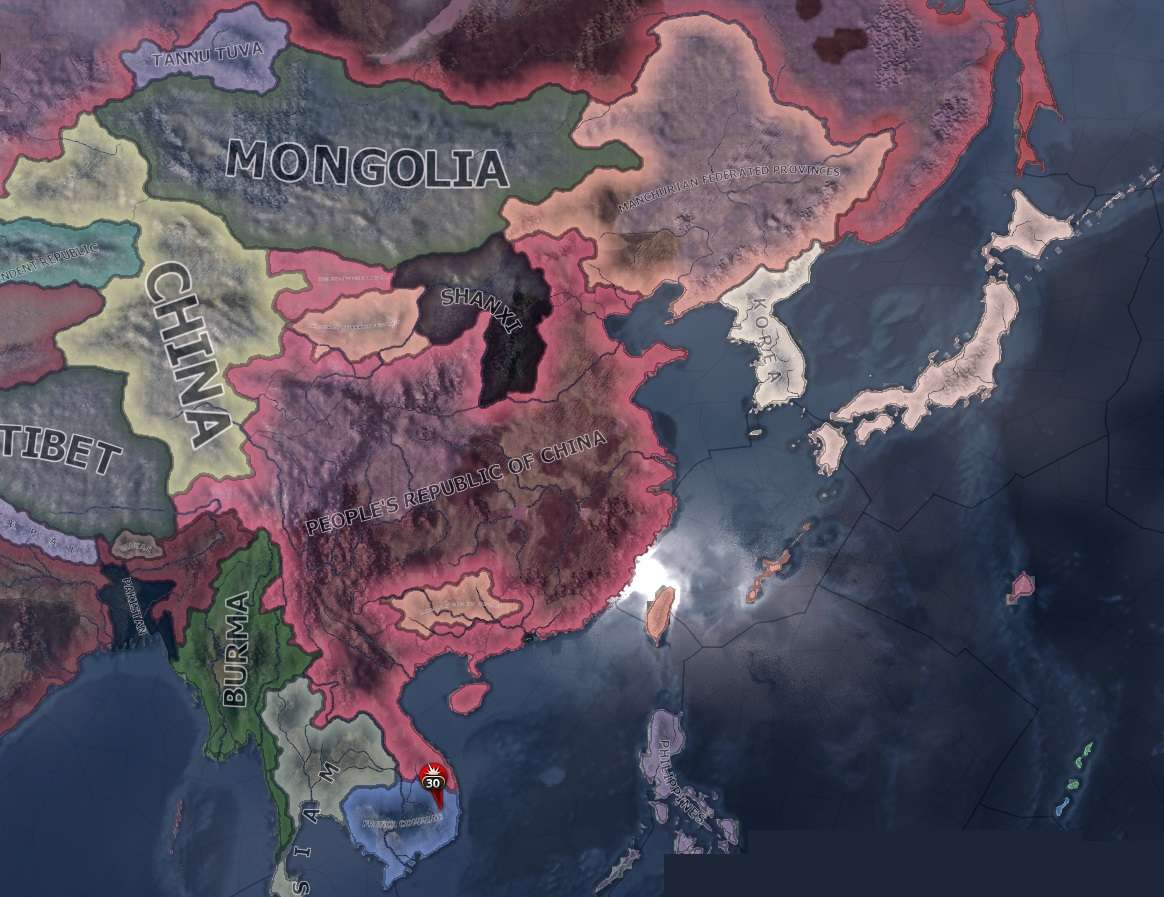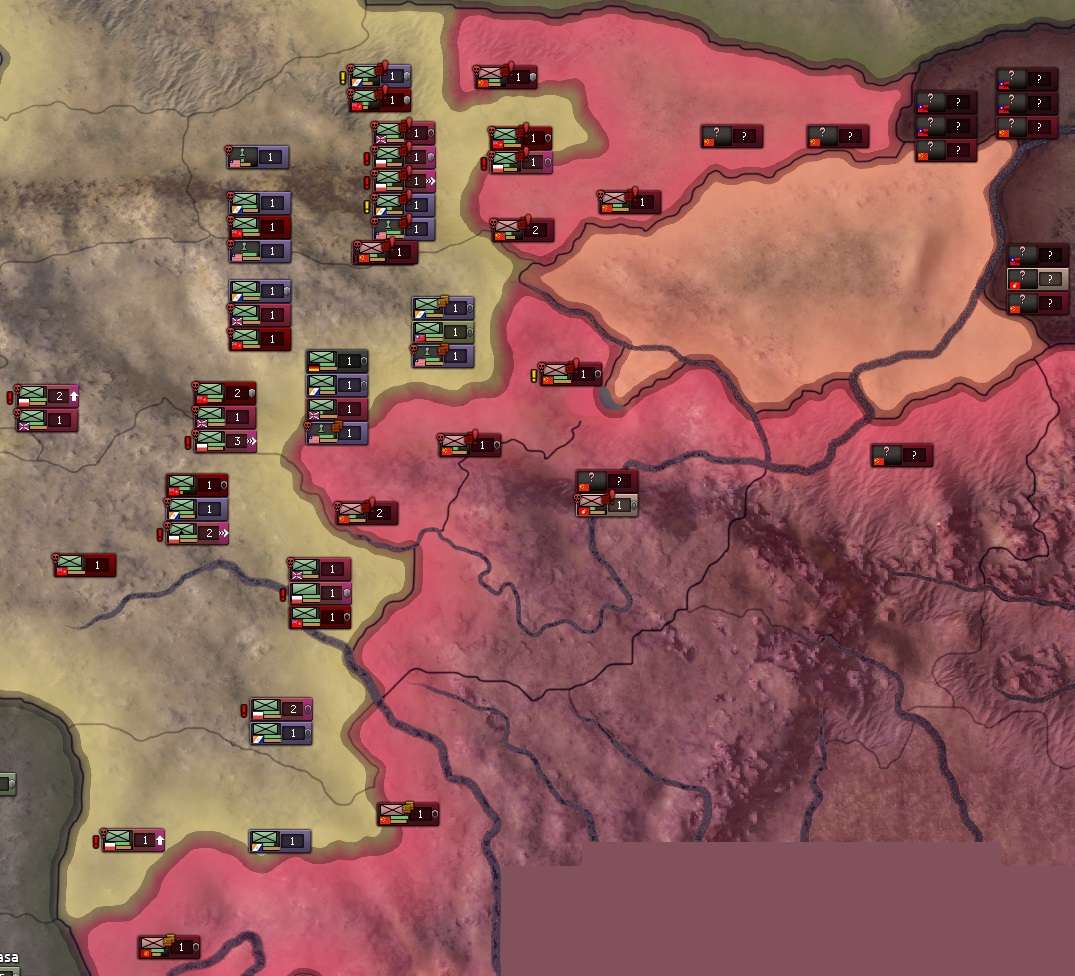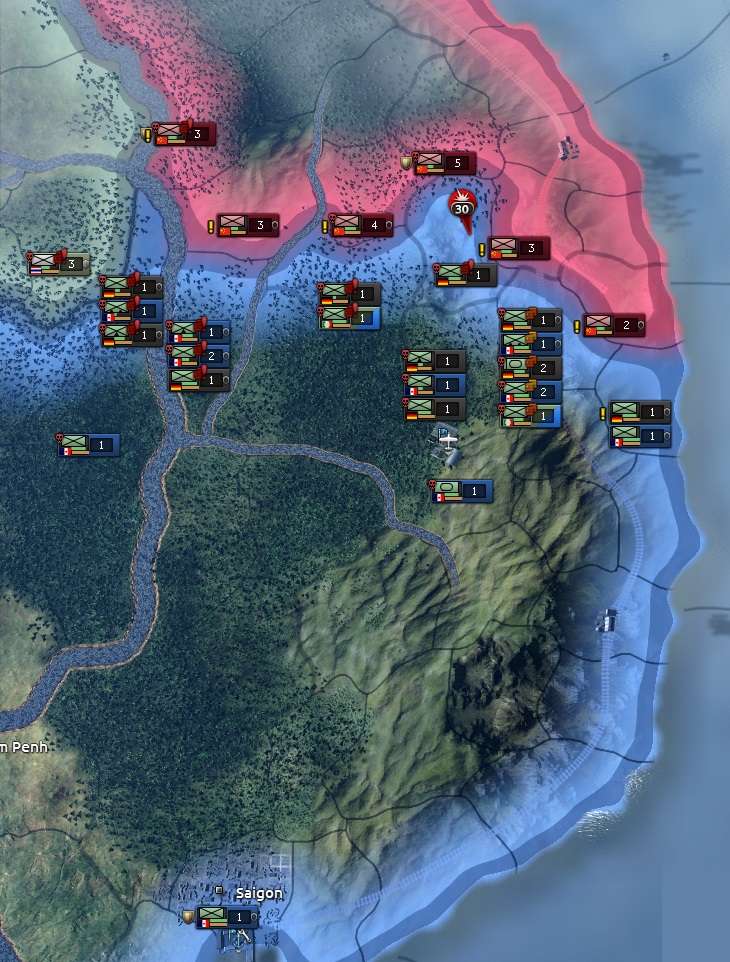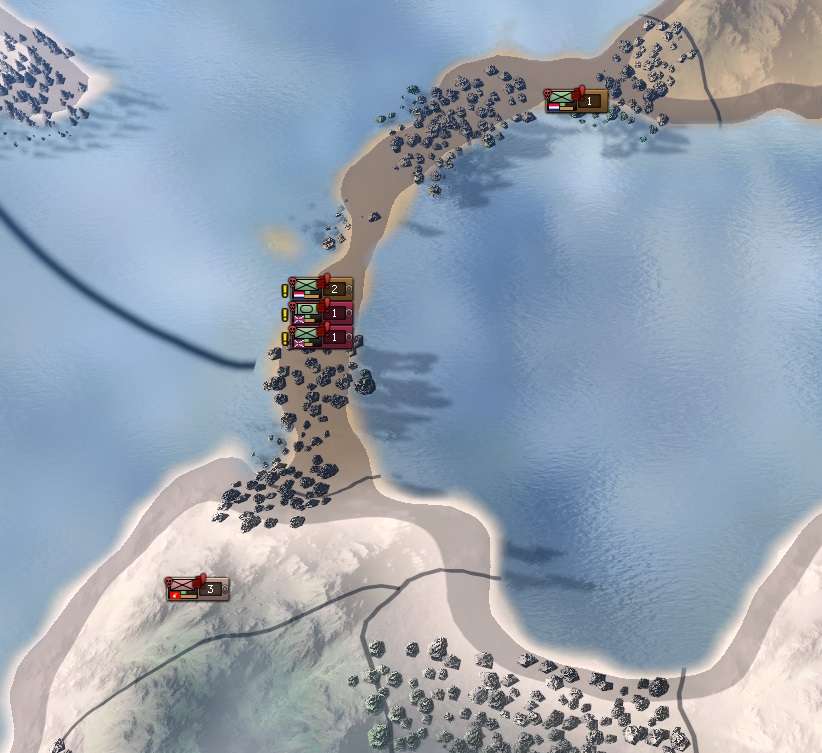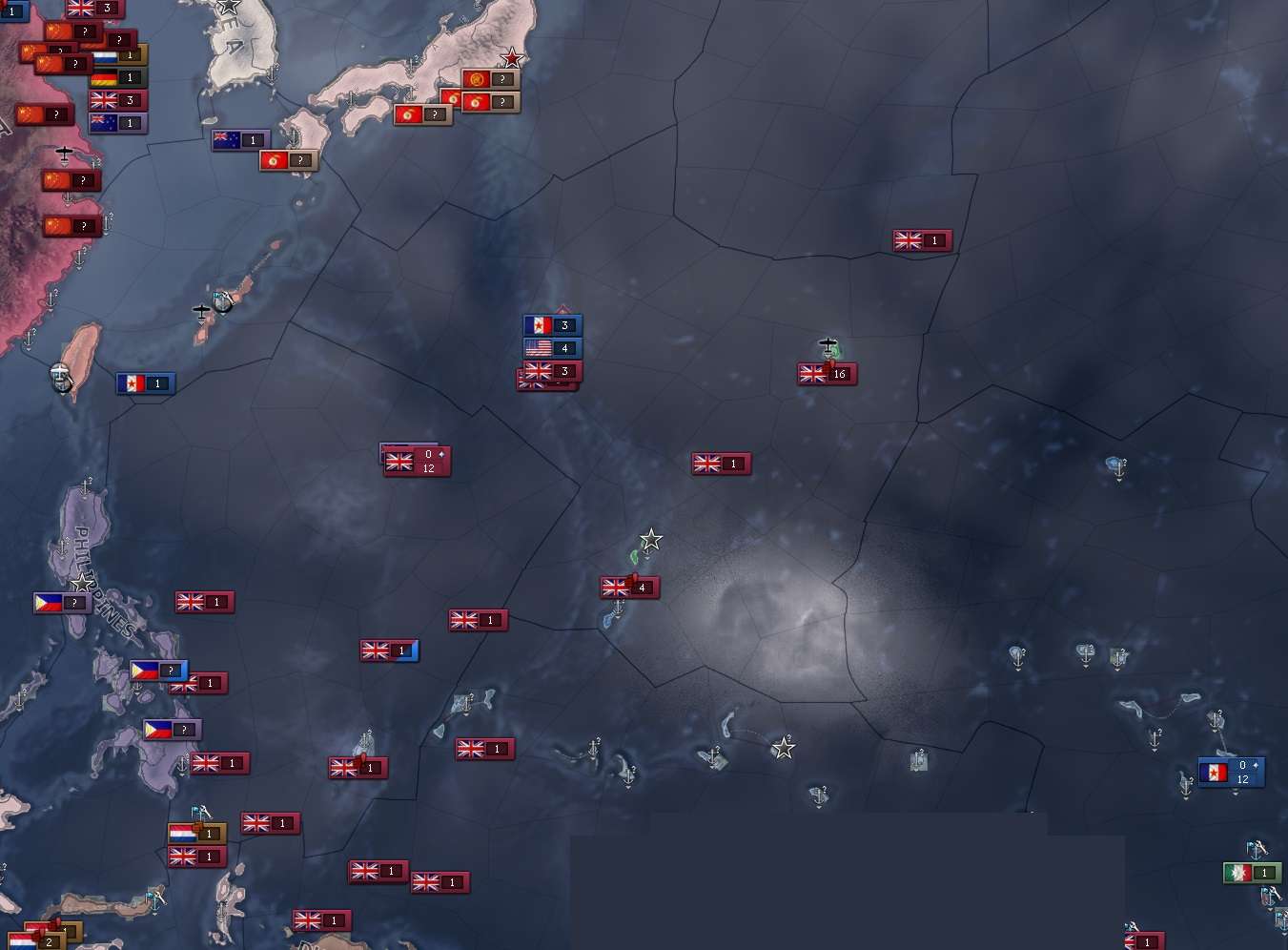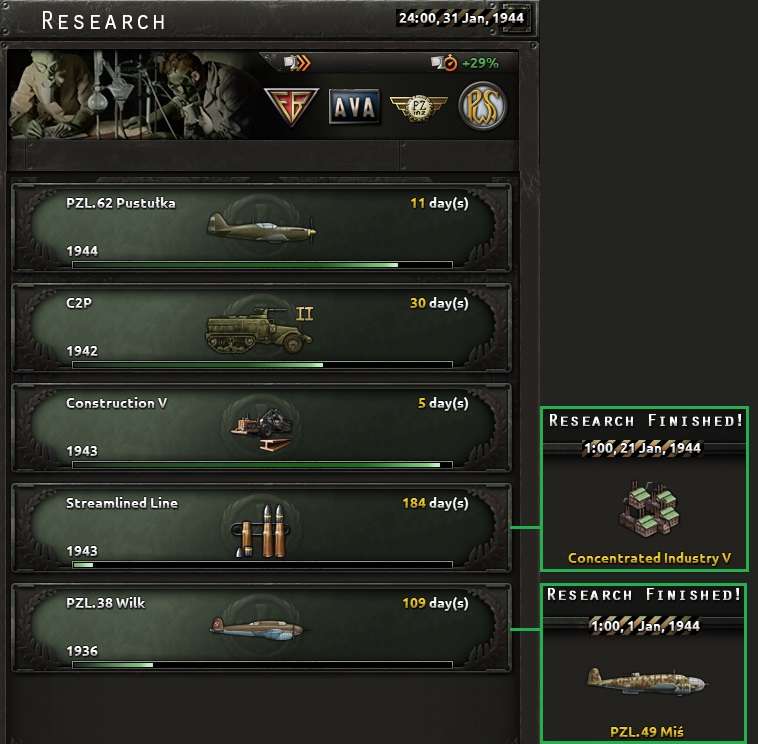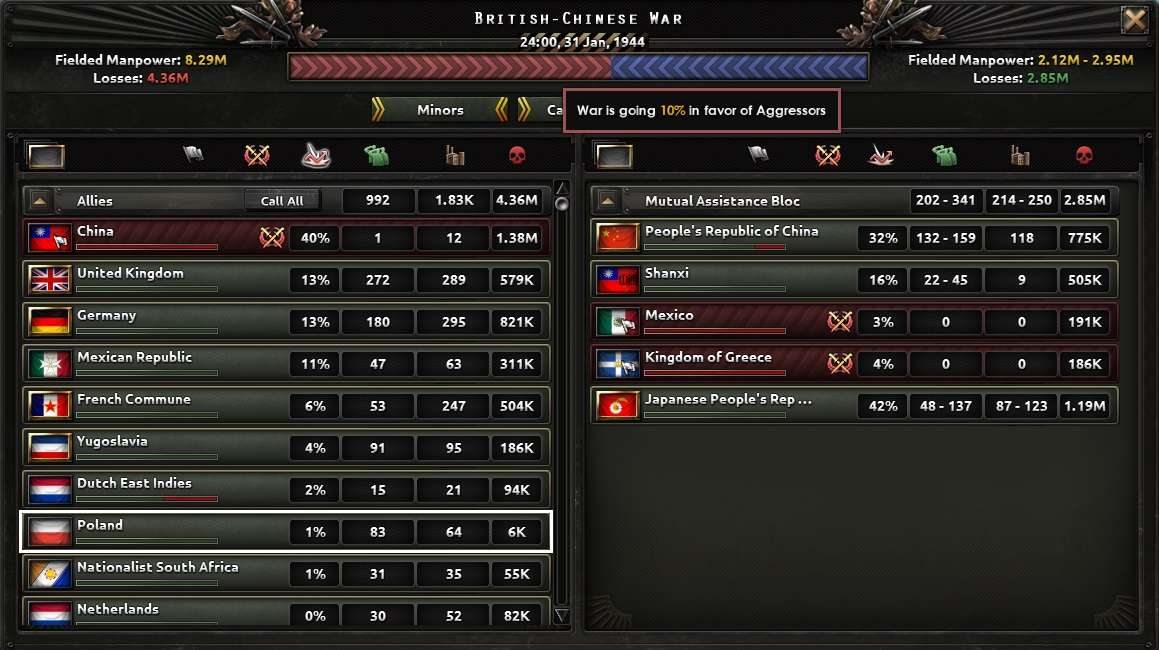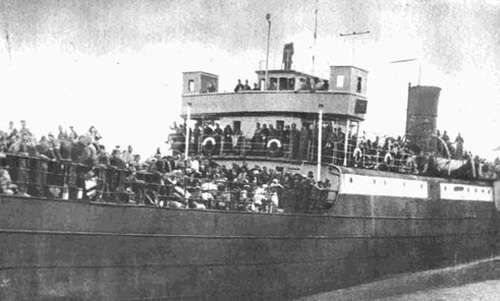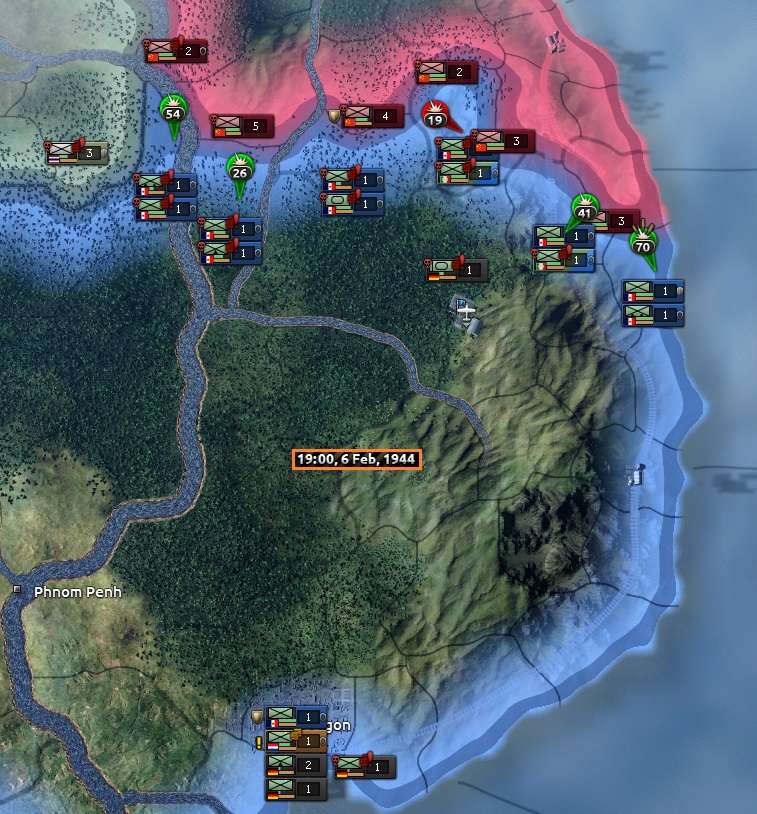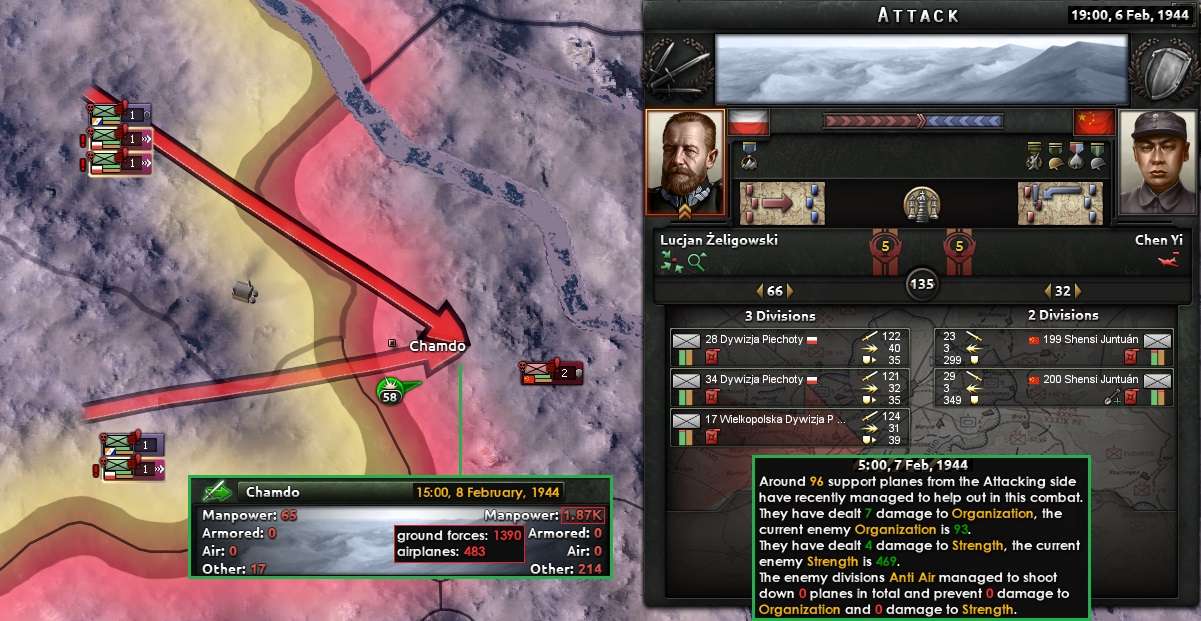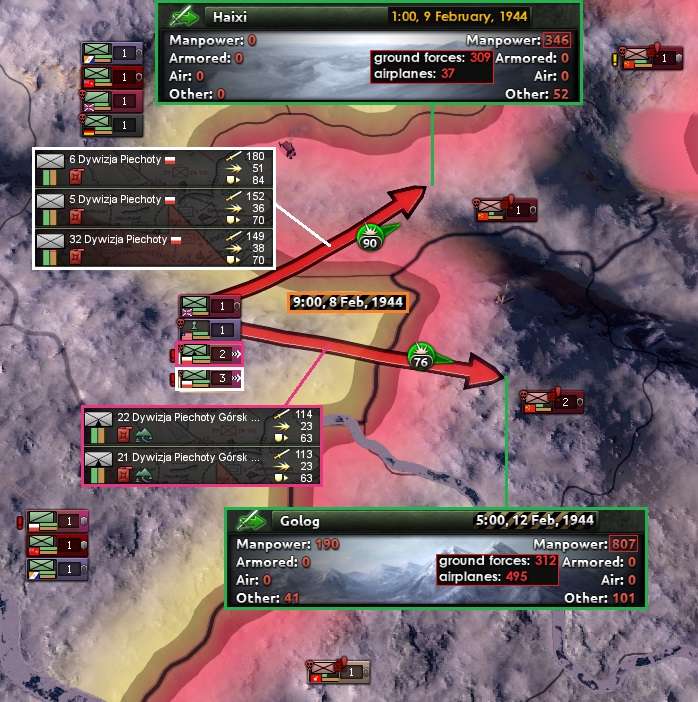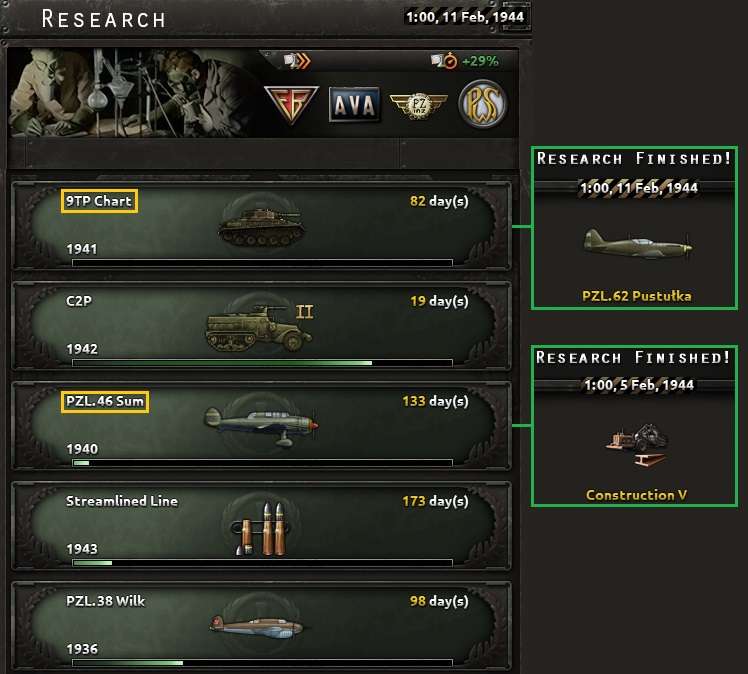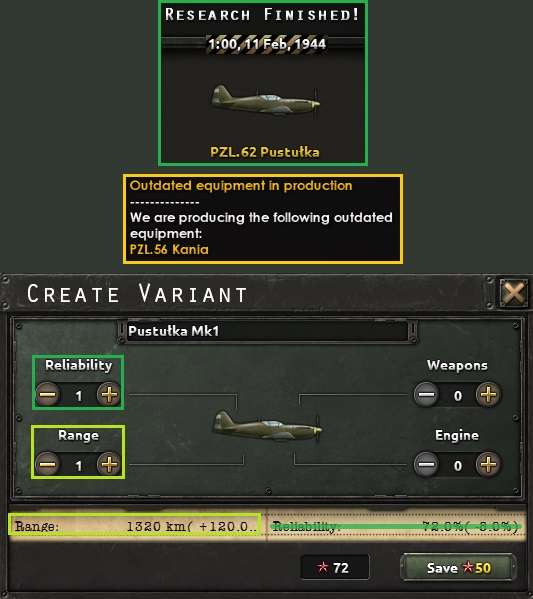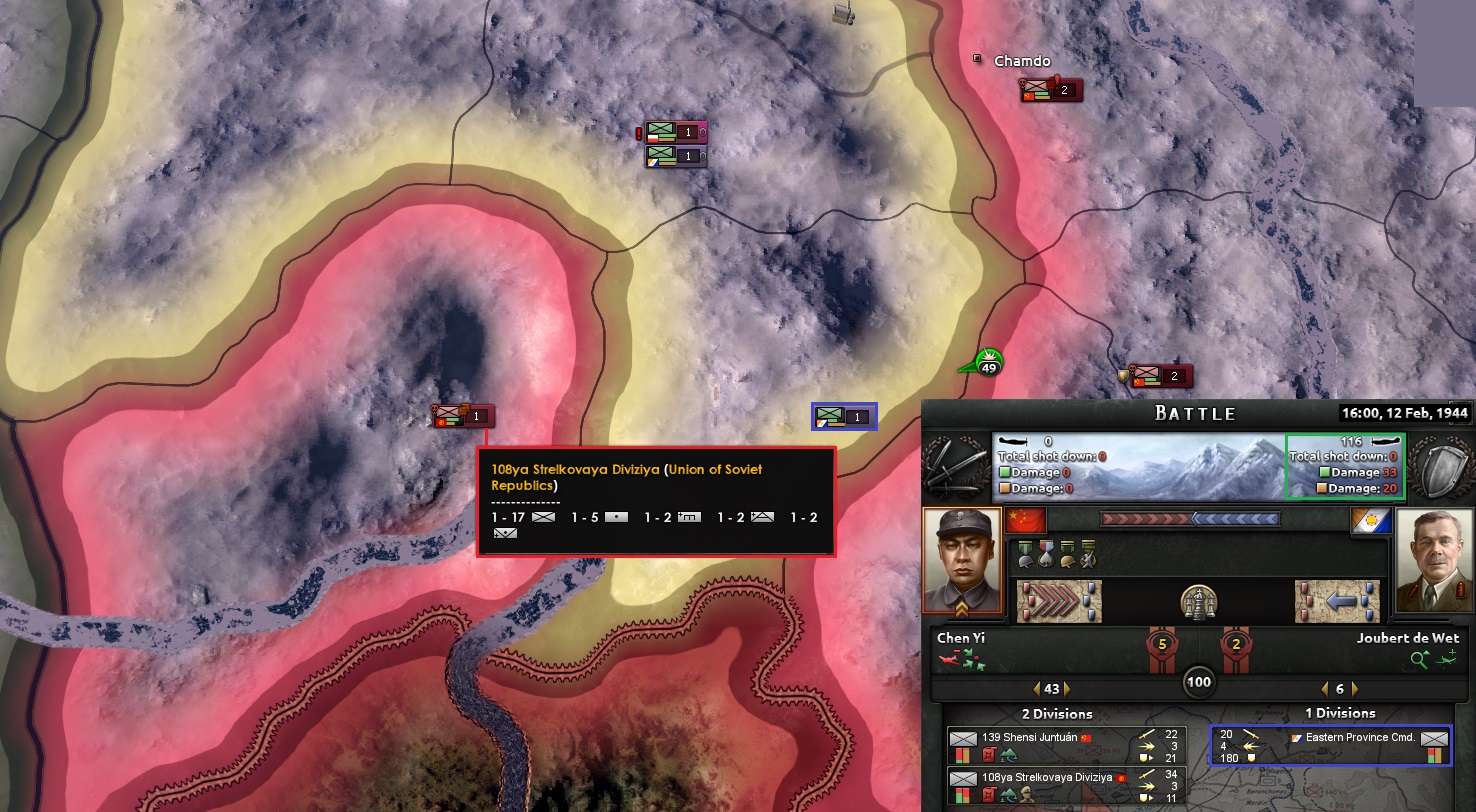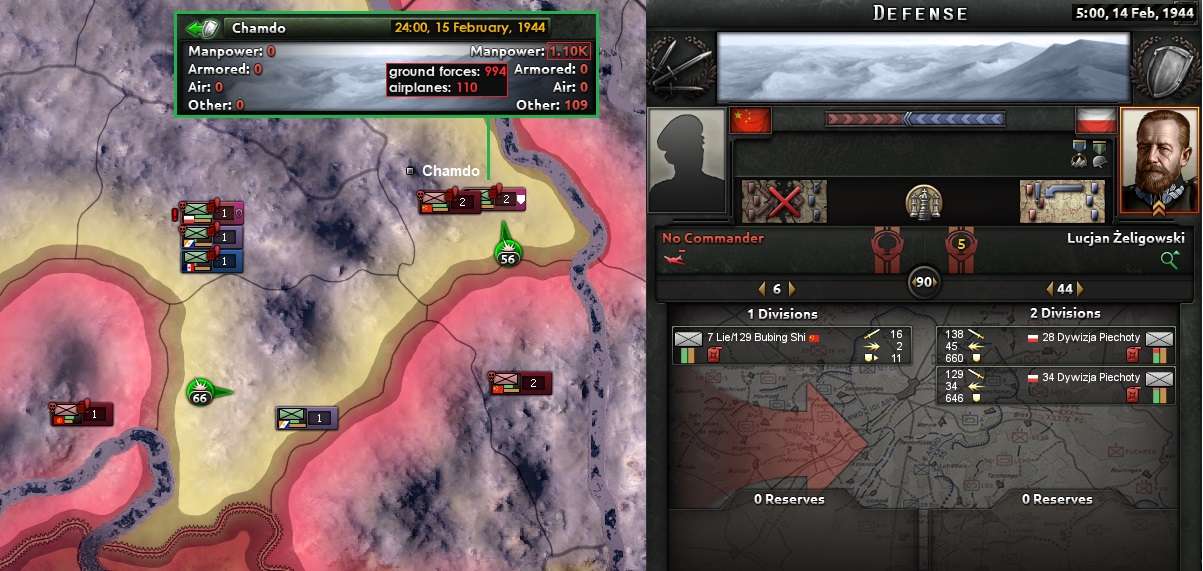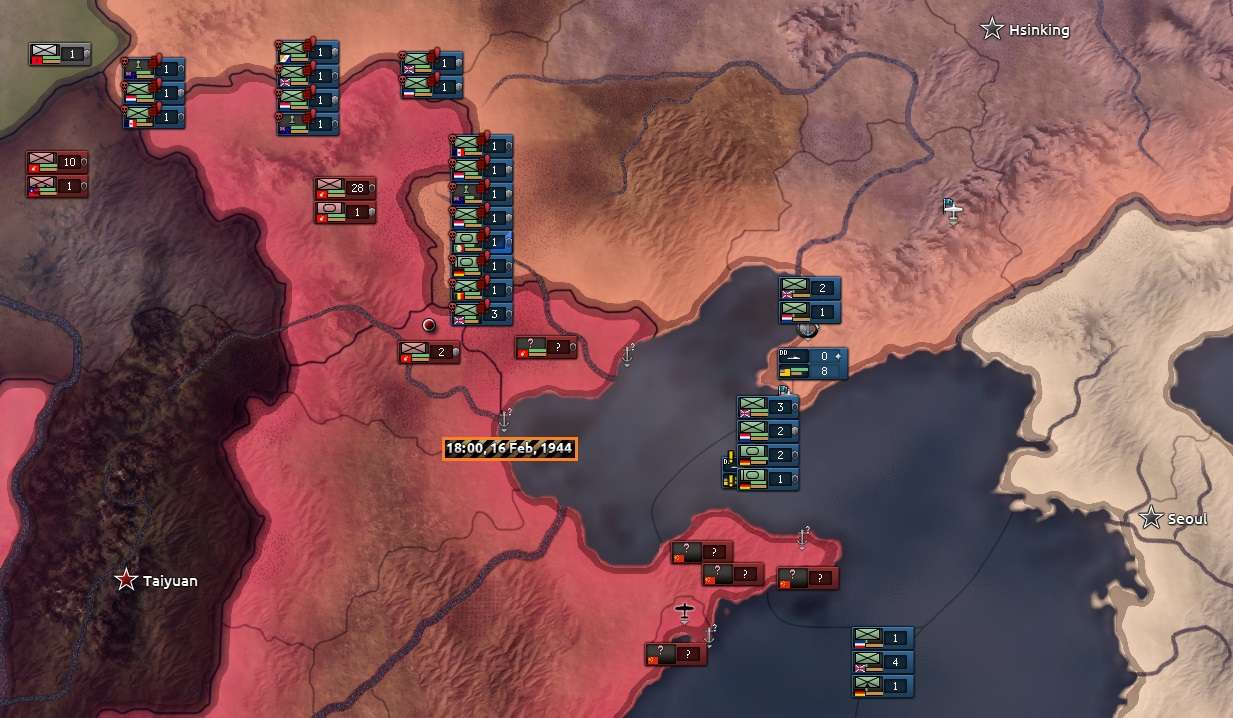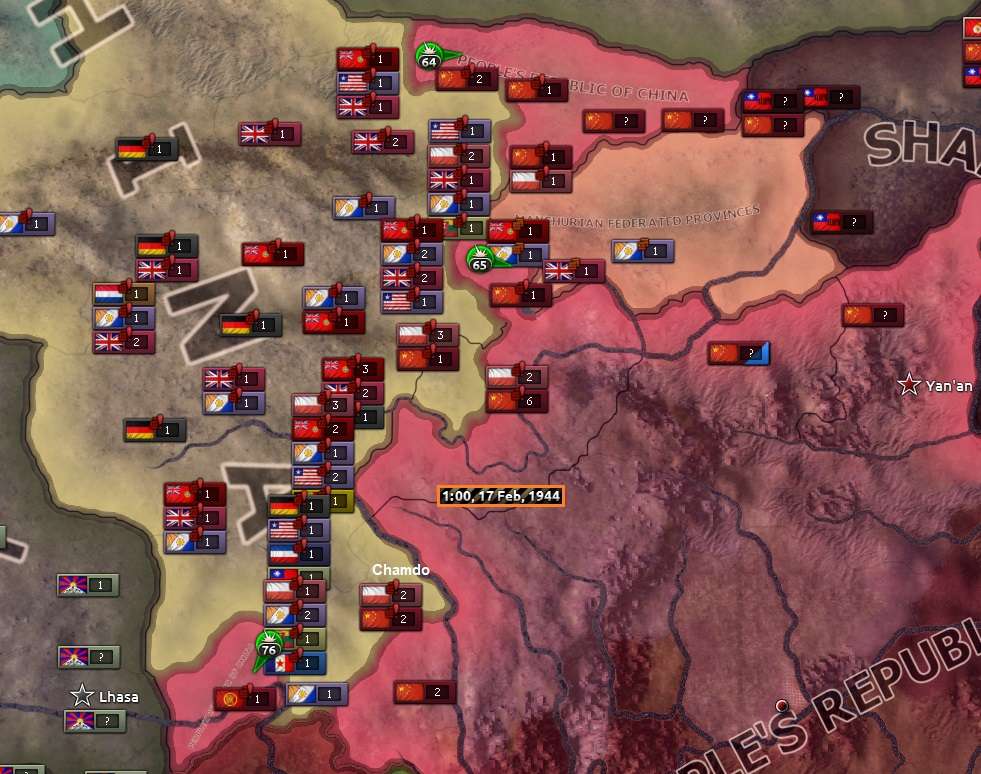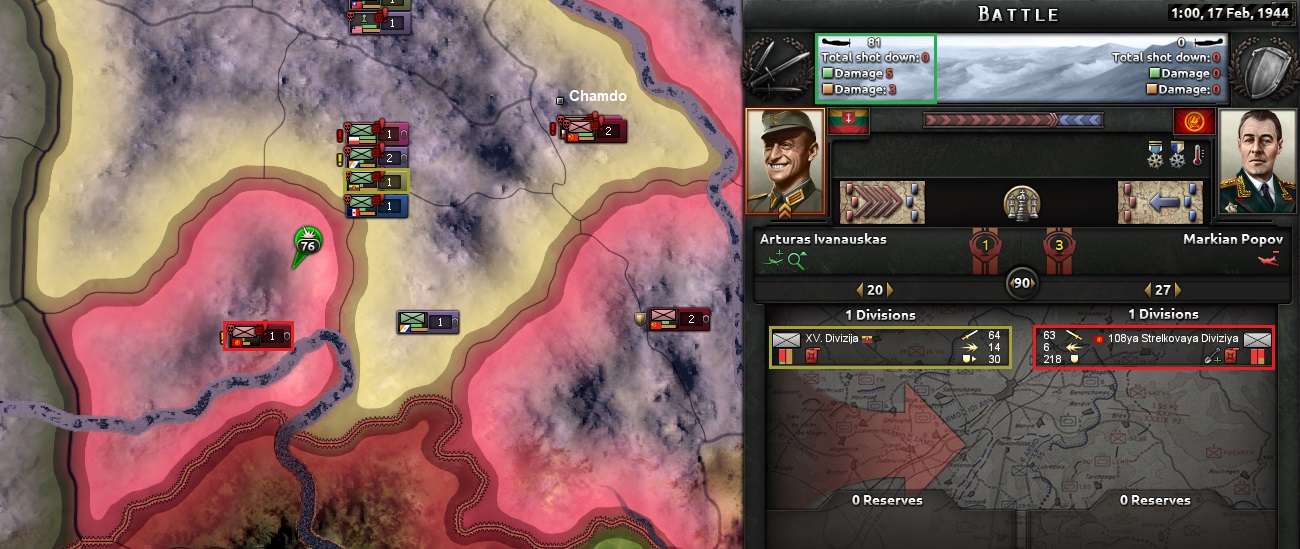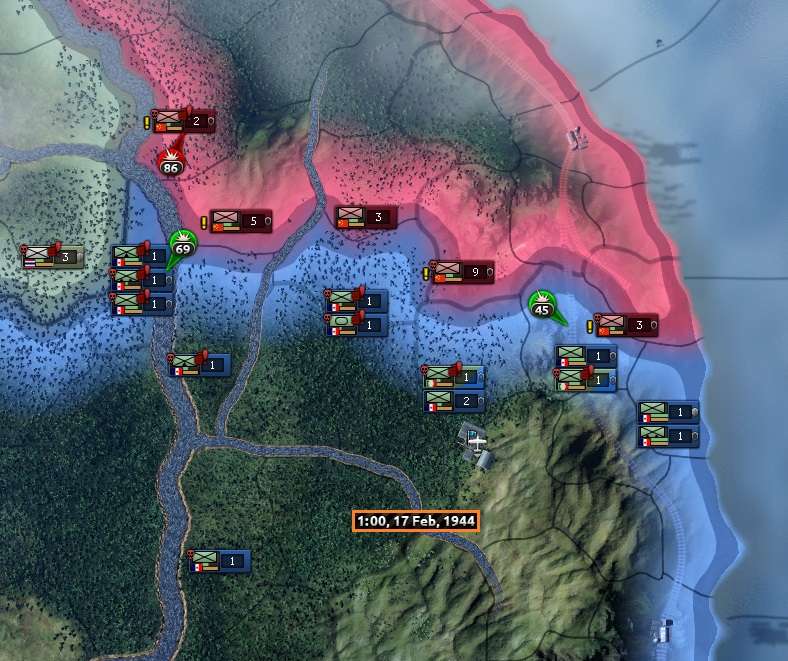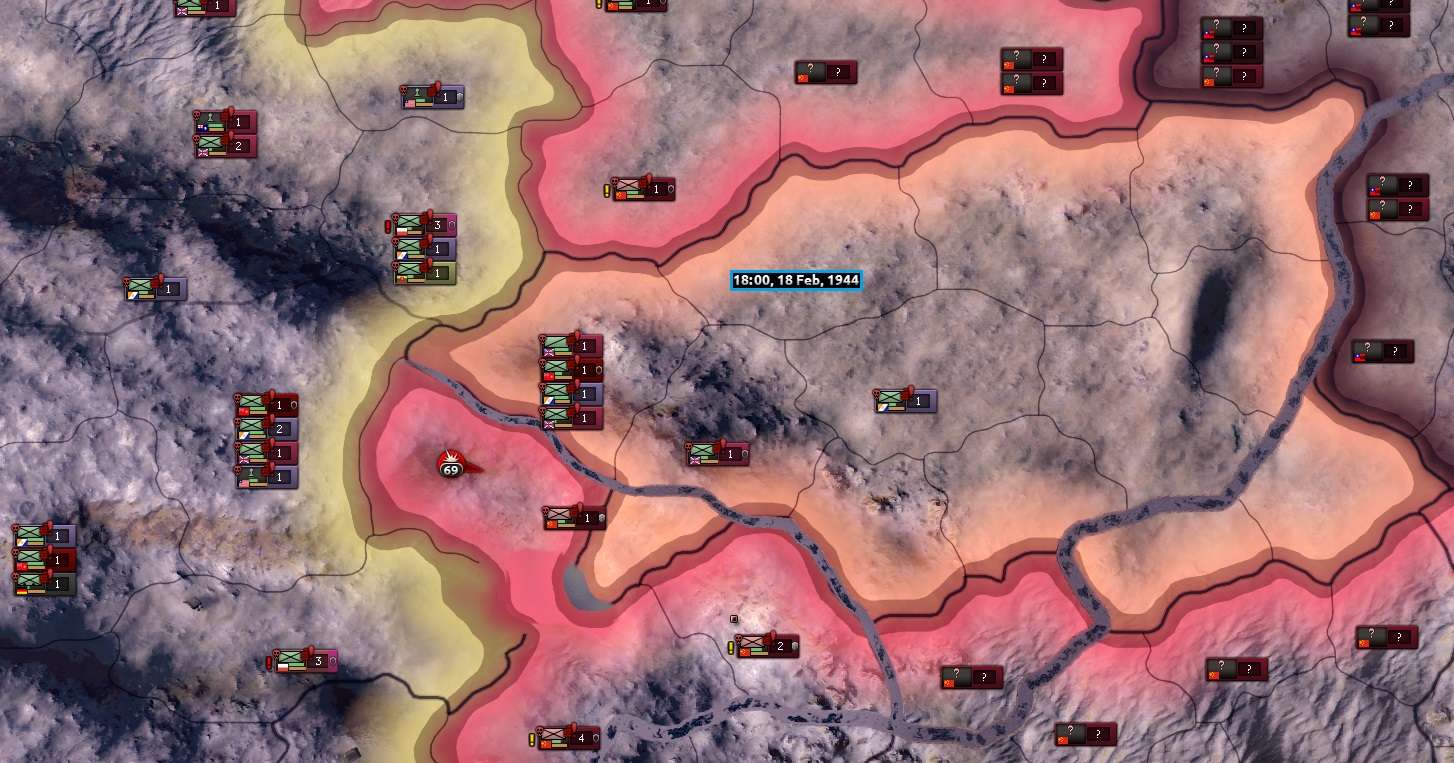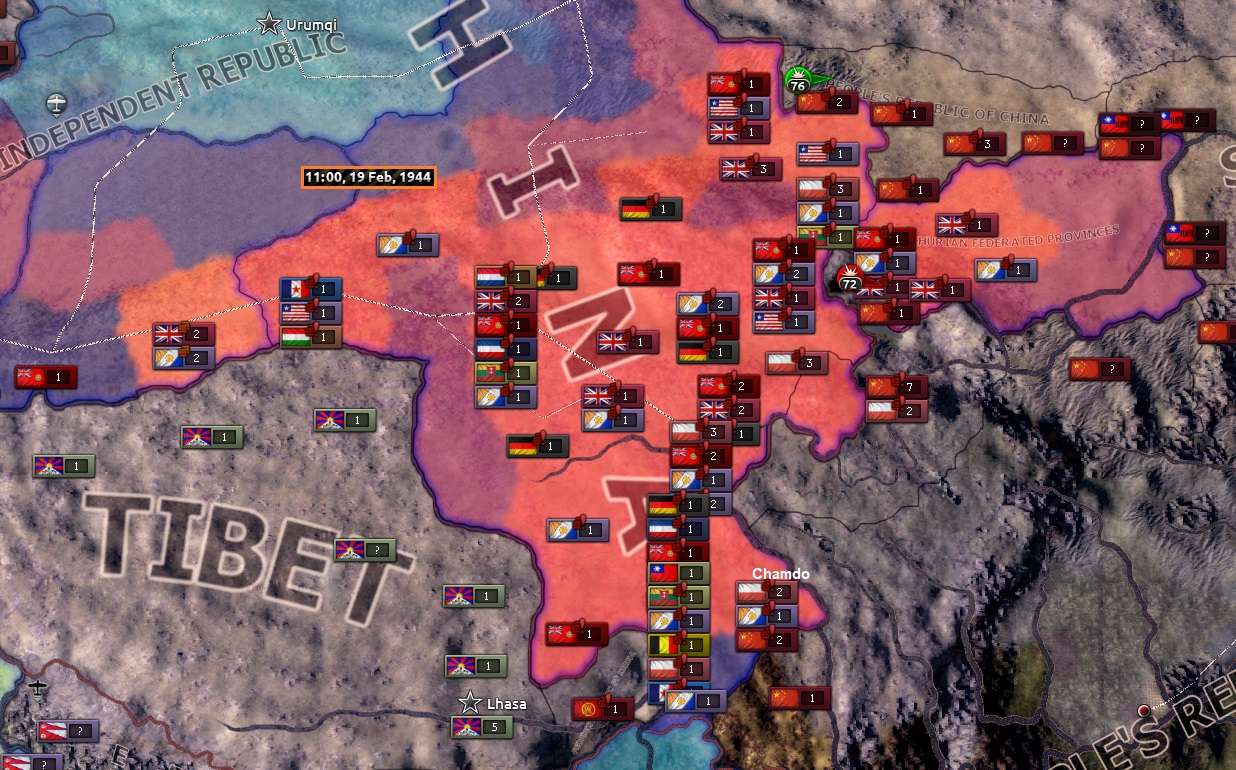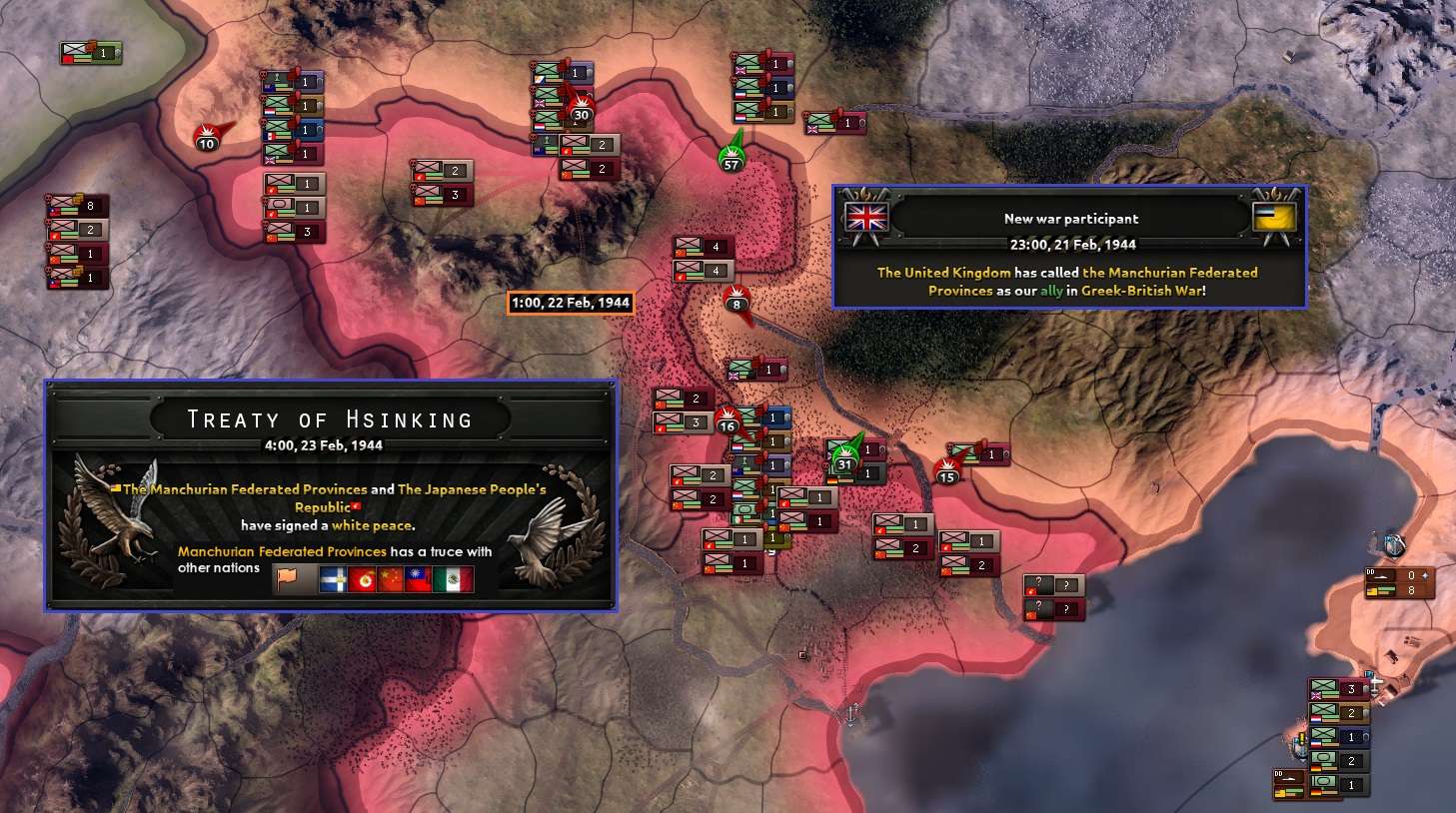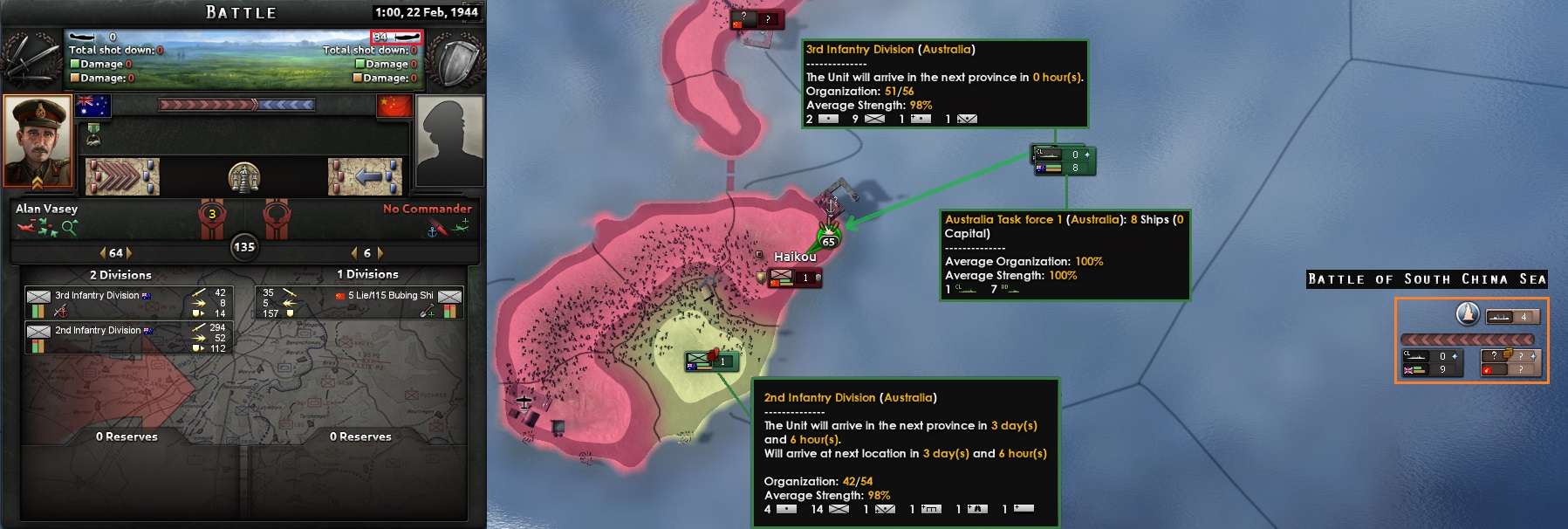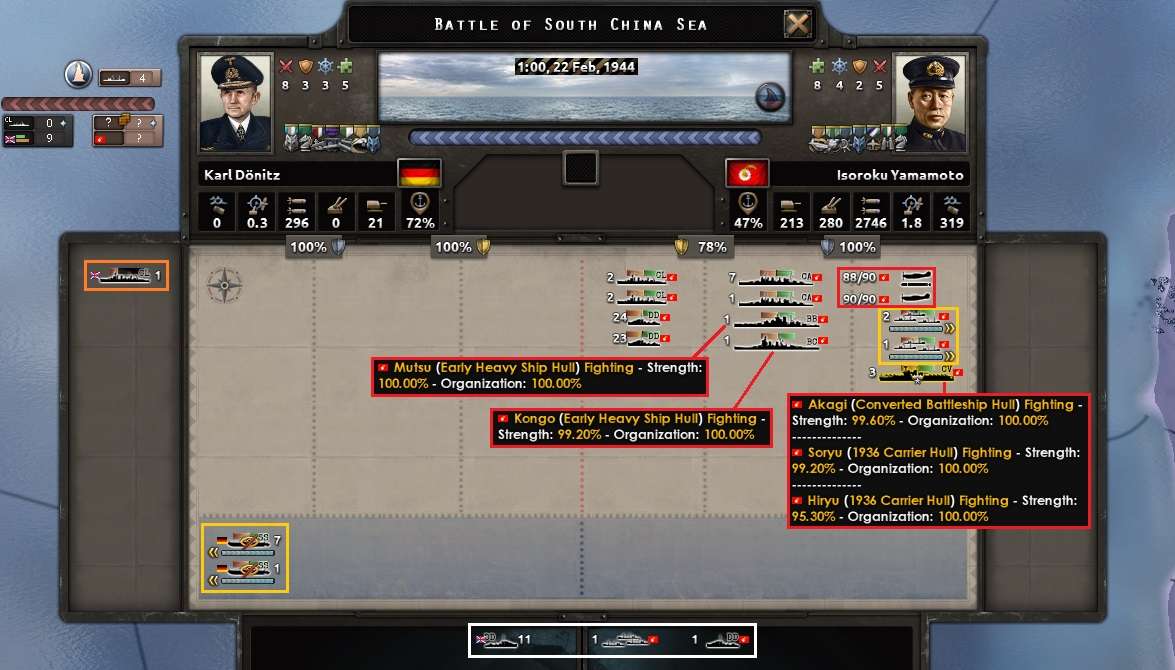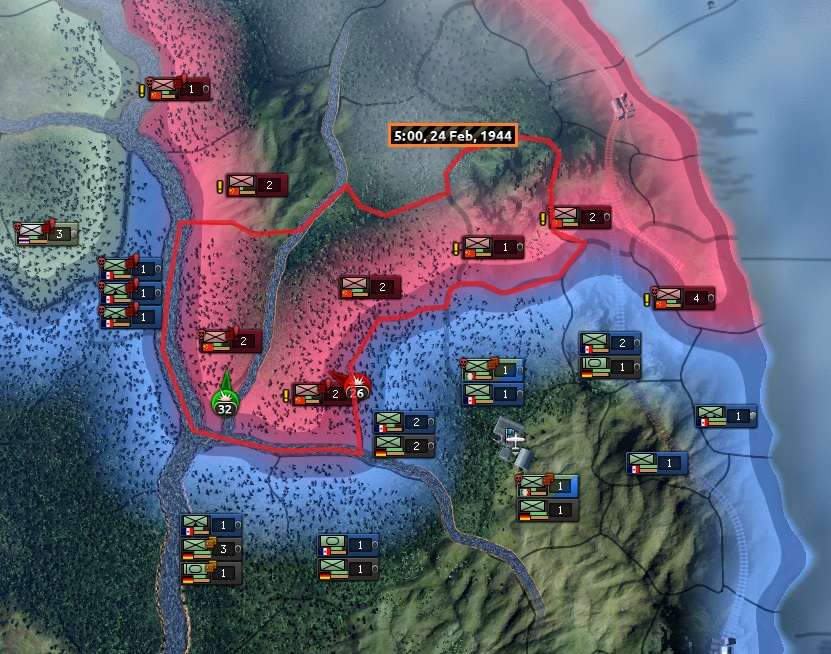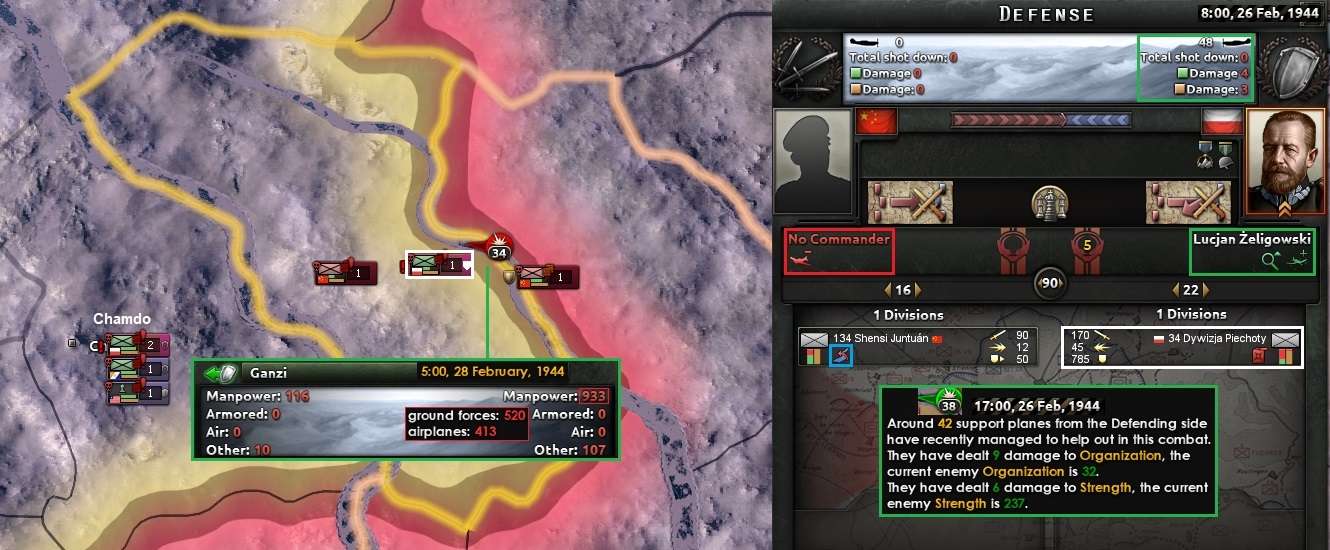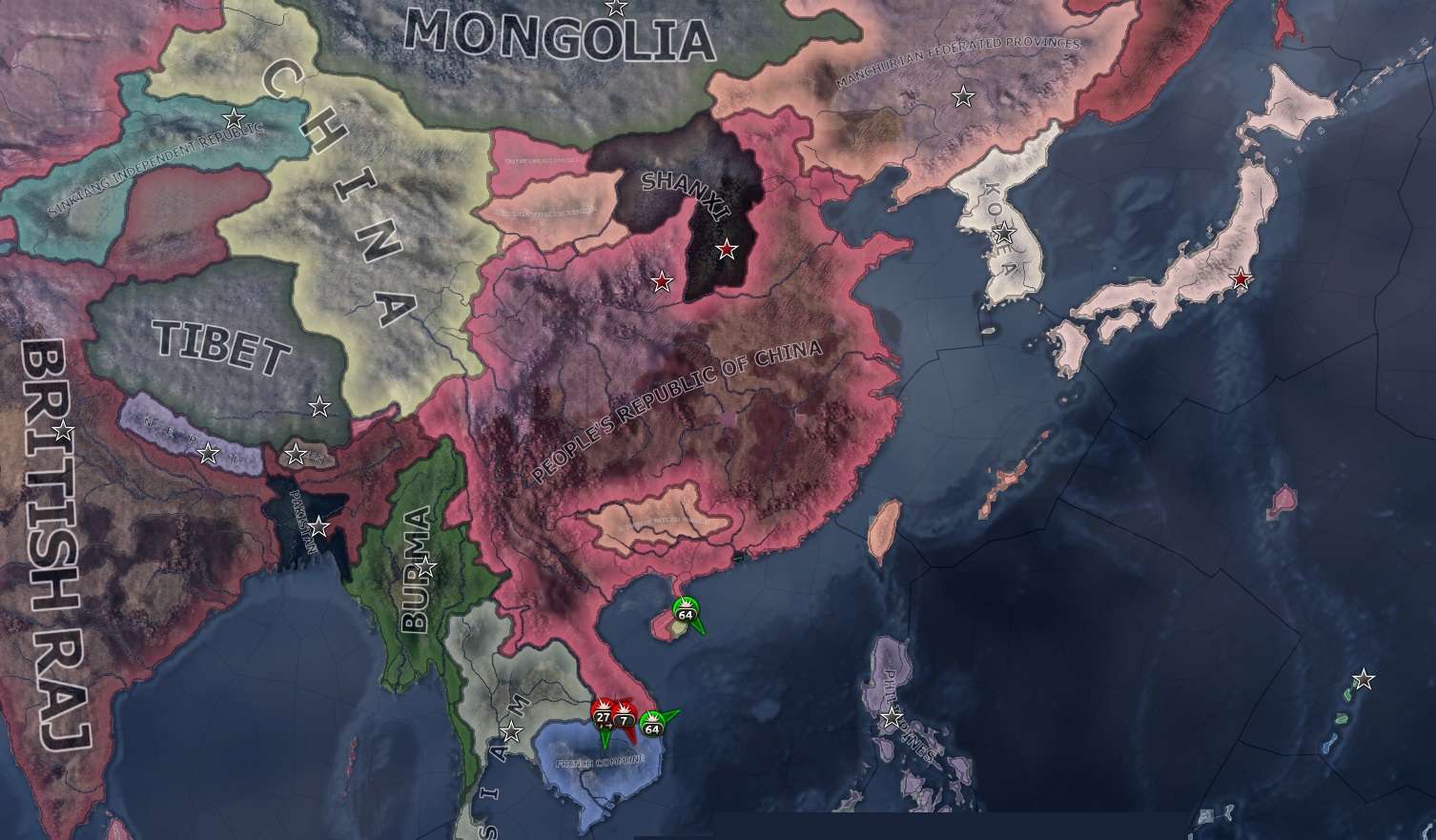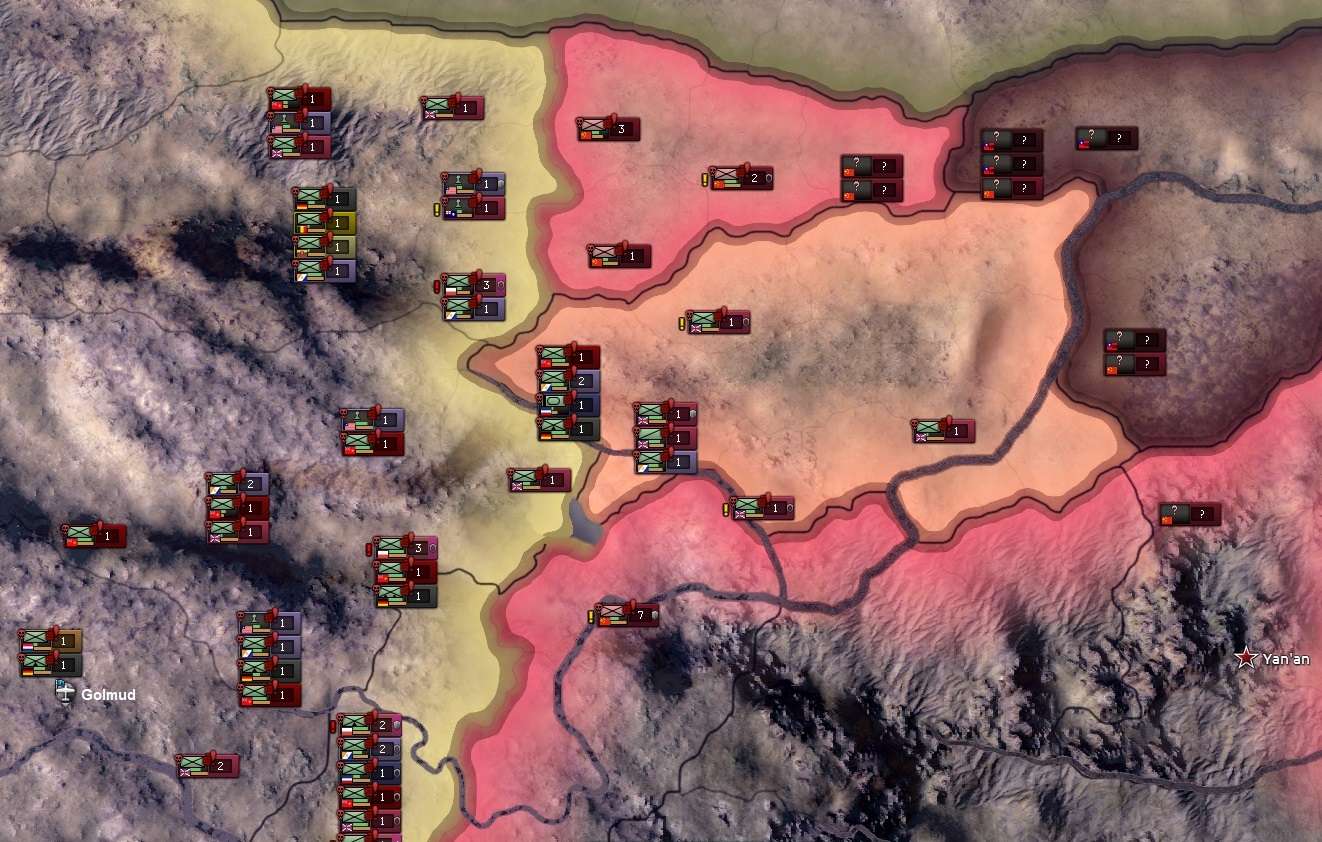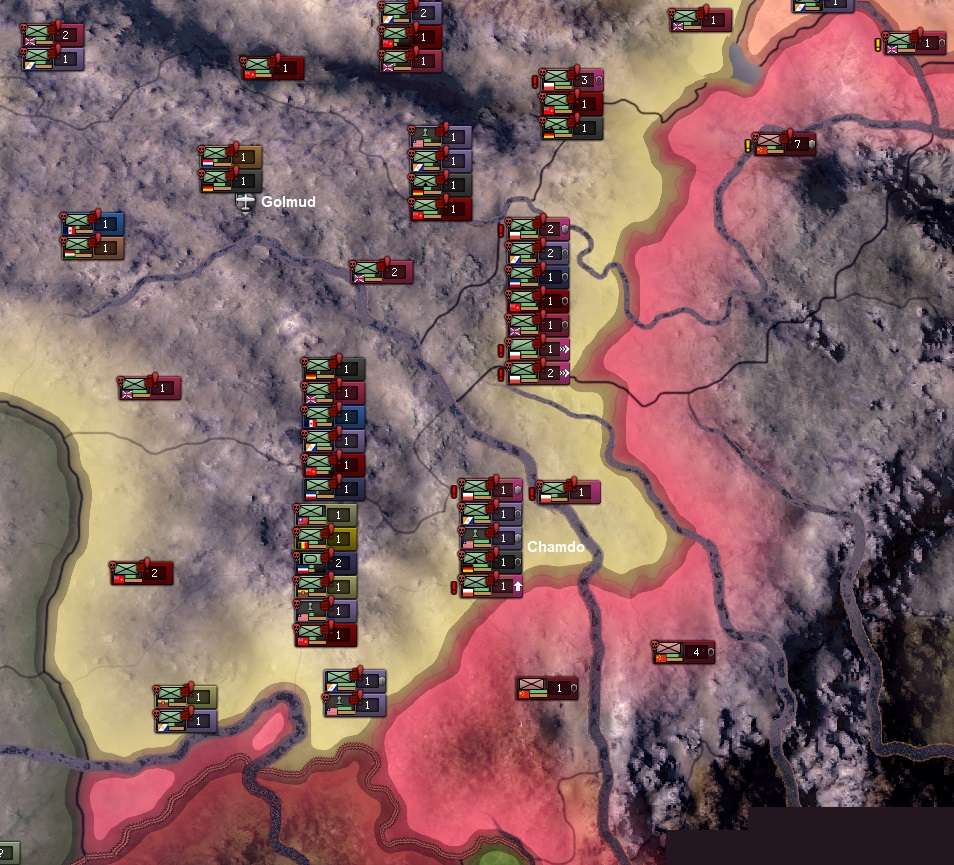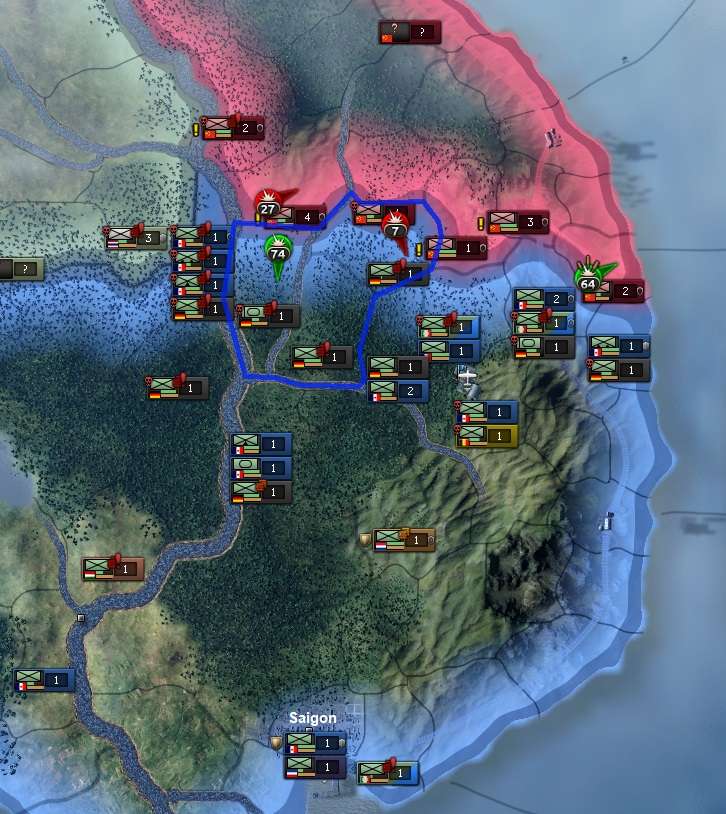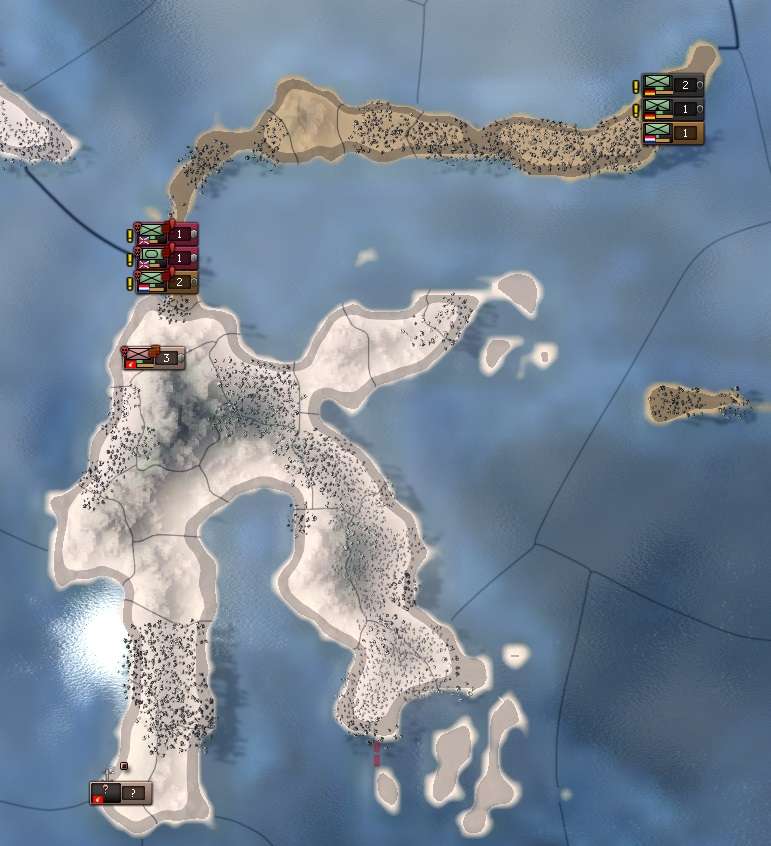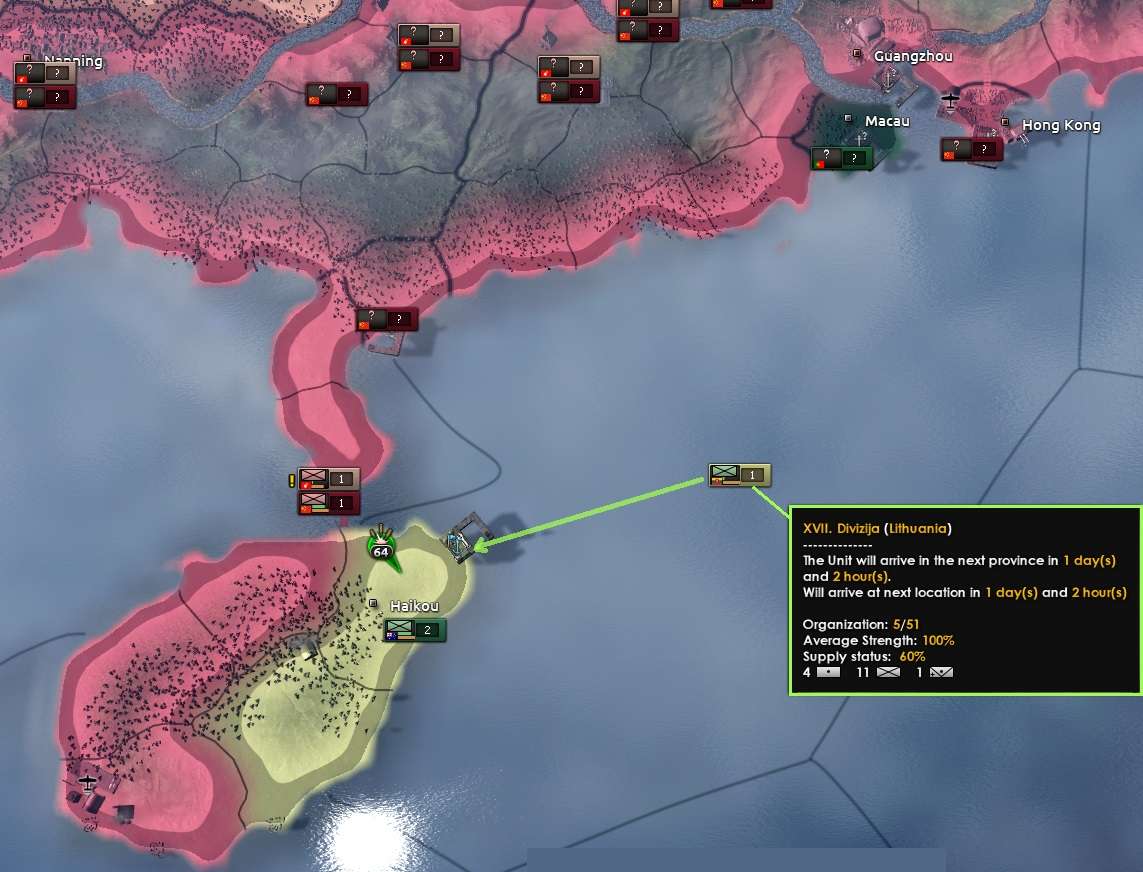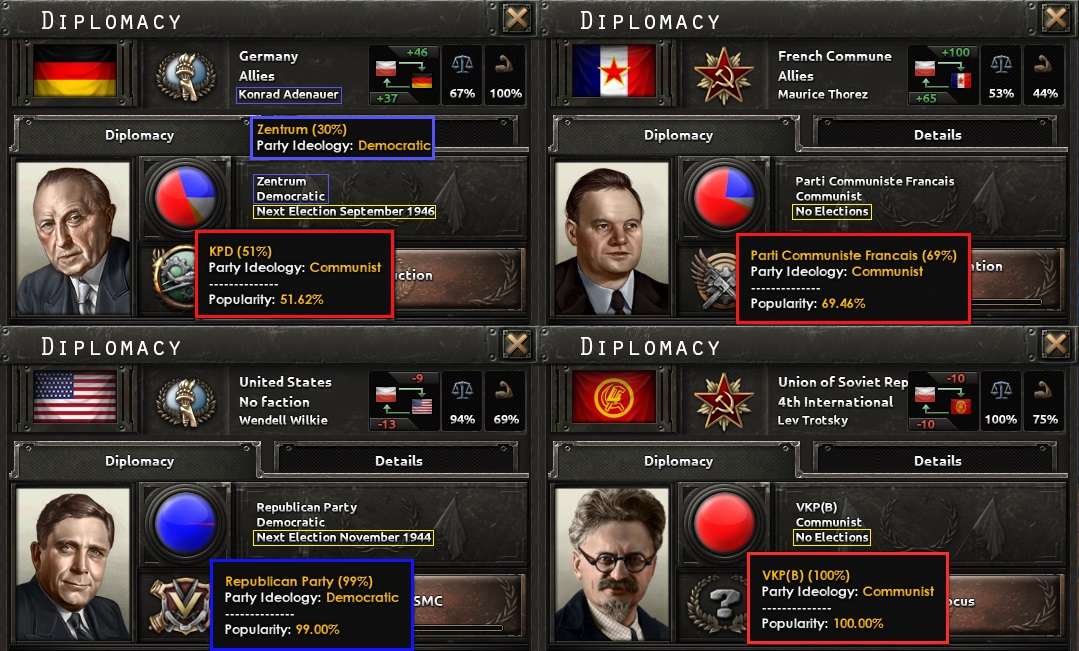Chapter Forty: To Hell in a Handbasket
(June 1944)
United States troops in combat, June 1944.
=
==
==
==
1-10 June: The Communist Offensive Continues
The second half of May 1944 had seen the Mutual Assistance Bloc’s offensives in Western China and Indochina intensify as Polish troops helped Allied efforts to hold the line in both places. The Communists were sustaining horrendous casualties in their human wave attacks, with many smaller battles in Western China and fewer but larger and longer attacks in Indochina, where the Poles were fighting in Tonkin.
In East Tonkin, a new PLA counter attack had opened on 14 May, just after another hard-fought defensive victory. The same had happened in West Tonkin, with the latest PLA counter-attack launched on 25 May. Both battles raged into the beginning of June 1944, while a PLA attack against Allied positions just to the west of West Tonkin in Laos was threatening to outflank the Polish position.
In Western China, a large ‘carry-over’ defensive battle in North Golog was won at 0700hr on 1 May, with 388 Allied and 4,020 MAB troops killed. In Indochina, Polish divisions were regularly rotated in and out of the front line to recover or be re-inserted after breaking or being withdrawn. On 4 June this resulted in the partly recovered 26 DP plugging the line in the afternoon five hours after the Allied defence of Western Tonkin was finally overcome in the morning. It began yet another long fight that would drag on for days.
By 5 June both battles in Tonkin raged on. 26 DP was holding on grimly but effectively, while in East Tonkin Allied air support was exerting a heavy toll on the attackers, while two Polish divisions were heady back into battle from the south as 16 DP tired.
From 6-8 June, yet another series of border clashes between the MAB and Manchuria followed its familiar path into a ceasefire.
On 6 June, the Polish wings in China rebased themselves, with out-ranged INT and CAS shuffled back to Urumqi while more TAC wings went forward to Qinghai to extend their close support range. Two wings would focus on the southern sector (Qinghai air zone) and one on the north (Western China air zone). And on the home front, a new civilian factory for Katowice was put on the production queue for when the current Western China rail upgrades were finished.
By that evening, 26 DP’s lone desperate defence of West Tonkin was failing
[19%] with 7 PLA divisions now piling on. By early on 9 June, they were barely clinging on
[6%] as they hoped for some Allied reinforcements. And at 0600hr some did arrive: the French 58éme Infantry joined in reserve, though this only marginally improved things
[19%]. By 0900hr they had reinforced and a Yugoslavian armoured division had arrived
[27%]. Things had improved further in the early afternoon and the defence seemed to have turned the corner.
But the big news was victory in East Tonkin after 26 days of vicious combat, with by far the largest combined casualty count of any battle Poland had been involved in for the whole war. Another small probe was launched on East Tonkin that afternoon that was defeated by the morning of the 10th. While in West Tonkin, the exhausted 26 DP was withdrawn at 1800hr, leaving the defence to the Allies while the now largely rested 29 DP was sent from depth to replace them.
East Tonkin came under attack yet again at midnight on 10 June and this time the fighting would extend for another two weeks or more as both sides rotated divisions through the meatgrinder.
In Western China, by 5 June MAB attacks had petered out along most of the line, except in North Golog and Jiuquan: it looked like the major Communist offensive had been weathered.
=======
11-15 June: A Sleeping Giant Wakes
With things slowly developing in the Allies' favour in Asia, none were prepared for the bolt from the blue that struck on the afternoon of 11 June 1944. The US had finally entered the war. Against the Communists. But not the MAB: for reasons that mystified all observers, the perhaps unhinged US President Wendell Willkie declared war on the French Commune!
This notionally made them co-belligerents with the MAB, though the US remained apart from any factional alignment.
By that afternoon, all remained quiet along the northern and southern borders of the US, though the UK, Canada and the Mexican Republic were all members of the Allies but not yet involved in the war. Yugoslavia had however answered France’s call to arms.
At 1800hr, the UK joined and took over the leadership of the war against the US. Anticipating a more hostile naval environment in the near future, the Polish Navy’s two small flotillas were recalled to Danzig from the Mediterranean that evening, just in case.
Sure enough, France’s call came to President Mościcki on the evening of 12 June. Poland, ever the dutiful Ally, answered the call to a war that had since expanded further, including to Germany and Italy.
A day later, the US dragged its puppet the Philippines into the conflict. By then, fighting had been going on in Iwo Jima for a few days, where co-located US and French troops had come to blows and then British-controlled (EF Chinese) had joined the battle in reserve by the evening of 13 June.
British troops guarding territory in the French Caribbean were also under attack and would be pushed back into British territory by the following morning.
By 14 June, both the battles in Tonkin continued, both somewhat in Allied favour, the more so in East Tonkin, where the fresh Polish divisions had arrived in reserve. But again, the big news of the day came from North America: after a delay of three days, Canada had joined the was against the US at Churchill’s invitation. Fighting erupted all along the Northern Front, from the Pacific to the Atlantic coasts, with a flurry of American attacks, many of which had Anglo-Canadian defence back-pedalling.
Back in Poland, the Chinese rail projects were all finished by 15 June, with a new civil factory started in Poznan to add to that being built in Katowice. That day, a welter of new countries become part of the Allied cause against the US, at the invitation of either the UK or Germany, including Australia, New Zealand, South Africa, the British Raj and the Dutch East Indies.
The conflict had finally broadened into a world war, albeit a politically confused one. Only the Soviets now stood apart of all the major powers, as American subs attacked an unescorted British convoy off the west coast of Mexico.
=======
16-24 June: A New Abnormal
By the morning of 16 June, two of the US divisions on Iwo Jima had surrendered as mix of Allied divisions piled on in Iwo Jima 3 at the front, another 15 in reserve) under General Charles de Gaulle
[+89%]. Fighting continued across the Canadian Front, with the Allied defenders doing better in the east than the centre and west.
The fighting continued unabated in Tonkin, with 16 DP evacuated from East Tonkin and the mainly rested 26 DP ordered north from depth to replace them. That night, 100 Allied planes engaged an American ‘wolfpack’ attacking a British troop convoy off Newfoundland as 8 Canadian destroyers raced to assist them. By the end of the day, Iwo Jima had been secured and the last American POWs detained.
The initial round of fighting on the Canadian Front was subsiding somewhat by the afternoon of 18 June, with a few American inroads made west of the Great Lakes as Tonkin remained a ‘hot zone’.
By the evening of 19 June, the Laotian province just to the west of West Tonkin was in danger of being lost to a PLA attack
[13%]. At 0600hr the following morning, it had deteriorated
[6%], while West Tonkin also took a turn for the worse again
[24%], with only a tiring 29 DP and an even more disorganised Italian division hanging on for dear life.
In France, Allied troop convoys were started to stream across the Atlantic, while 49 German and 41 Yugoslavian divisions (among others) were queuing up in north-west French ports for the crossing by the end of 20 June.
The establishment of the National Defence Fund in Poland on 21 June triggered a major boost for construction efforts, with around 9 factories being freed up for projects and allowing a third new civilian factory to be started, in Płock. The next national focus would be on completing more of the Four Year Plan by building the Warsaw Main Railway Station.
A good example of the current as yet sporadic naval warfare taking place in the Atlantic was another American convoy raid near the Canadian coast. But this time, almost 200 aircraft and the 8 patrolling Canadian destroyers had been able to offer more protection, with the US subs forced to disengaged, many of them carrying considerable damage. One sub and one transport had been sunk.
By the evening of the 21st, West Tonkin held on
[26%], but the battle for the Laotian province to its west had been lost. The Poles would fight on, hoping the Allies – whose line across Indochina seemed have thinned somewhat in recent days – could contain the threatened Communist breakthrough. In better news, the Allies now had good momentum in the defence of East Tonkin. Just as a pack of 5 Italian subs engage a Philippine convoy of 3 transports just off the coast.
In Western China, it seemed the recently upgraded railroads had improved Allied supply and organisation. This may have been partly behind the blunting of the Communist general offensive, which now saw Allied units (not yet the Poles, who continued to rebuild organisation) resume the attack in the central and southern sectors.
On 22 June, West Tonkin had barely stabilised, while 16 DP was returned early from its R&R
[19/54 org, 90% strength] to try to hold the fiercely contested province, as the PLA occupied the bordering Laotian province. When it was taken, administrative control of Laos was returned to the Japanese, while the PRC still controlled northern Vietnam.
The development of the PZL.46 Sum CAS design was completed on 24 June, with the next model, the 1944 generation PZL.59 Okoń, going into immediate research, while the production lines were tooled up to produce the new ‘Sum’ in the meantime. When the ‘Okoń’ was developed, there would probably be another range extension modification added.
Over in North America, the pace of combat had come right off, as the US consolidated limited gains made above the 48th parallel (only).
16 DP joined the battle in West Tonkin at 1700hr on 24 June, as the returned French 58éme clung on
[20%] but the exhausted 29 DP was evacuated to recover. In East Tonkin, the PLA had regained some attacking momentum as that fight raged on
[59%].
=======
25-30 June: Recalibrations
16 DP reinforced 58éme on the evening of the 25th, immediately stabilising that battle as another Italian division arrived in reserve. By the next morning, things were turning around there. By 0900hr, another big victory had been won then in more good news, another epic defence of East Tonkin was won that evening.
By then, the Allied attacked in Western China had made twin breakthroughs in the centre and another in the south, though a couple of there were under heavy MAB counter-attack.
Improved supply had seen most of the Polish divisions in the sector back to near full strength and organisation, triggering advances on 26 June to either reinforce Allied breakouts or create new ones, with a corps-strength attack into Gannan meeting with great success by early on the 28th.
Allied plans for the Philippines now included possible amphibious landings in Luzon but none had yet taken place.
While in the US almost all American attacks had ground to a halt, with the Allies hoping to stabilise the defensive line and perhaps launch a future offensive to divide the US in half, though they were far from having that capacity at present.
Research on improved recon companies (Level II) was finished on 27 June, to be replaced with work on better field hospitals (also to Level II). These had not yet been introduced to the Polish Army, but this addition was now implemented for the main infantry division template. The manpower and trucks necessary to do this were to hand, but only about half the needed support equipment was in stockpile.
The production line saw the factory allocation for this gear increased from 1 to 3 at the expense of truck and AT gun production (and also temporary efficiency, down from 90% to 36.7%). And within a day, lend lease offers to assist with the deficit began to be received from generous Allies looking to offload surplus gear.
The PLA was unwilling to let East Tonkin go without yet more rivers of blood being split, with a new attack there starting on the afternoon of 27 June; it would still be going as the month ended.
All was quiet in Canada on 28 June, though the Allies had taken the southern most province of Alaska.
In Western China, the Poles finally got sick of soaking up all those Communist probes and decided to reinforce an existing Allied attack which was in some trouble. While their joining the reserve improved the odds significantly, the trend of the battle was still leaning towards the PLA defenders; at least until the Poles could start reinforcing the front line of the attack.
As the month drew to a close, more reports on the US and its intentions were provided through other Allied sources. The US was currently trying to improve its mobilisation speed – albeit perhaps a little late. Estimates of their military strength varied wildly but seemed to be firmer on industrial matters. Most worry was a report that they were seeking to become the first national to develop an atomic weapon. This sent shivers down the collective spines of the Allied powers.
On the afternoon of the 30th, a new PLA attack had been launched on West Tonkin as the fighting went on to the east.
=======
Theatre and Other Summaries
Momentum seemed to have swung slightly back in the Allies’ favour in Asia as the MAB once more absorbed very heavy casualties (noting those provided below only related to battles in which Poland had participated and there had accurate reporting). Of the Allied combat casualties, only around 2,500 were directly attributed to the Poles.
Supply on both fronts continued to be quite reasonable, with noticeable improvements in Western China from the poor state in May.
One province had been lost in south-eastern Laos, but the breakthrough had been limited. East Tonkin in particular had been a bloodbath in June.
In Sulawesi, one province had been lost at the base of the peninsula, but a strong Allied counter-attack was in progress.
Communist attacks in Jiuquan had continued all month, but as mentioned above these had been easily resisted and now the Poles were helping the Allies to push back a little.
After the Communist offensive largely faded away by mid-June, in the central sector the Poles were now backing up a renewed Allied advance, having just secured Gannan and assisting an Allied cross-river attack south-east of Lanzhou.
There was no action at all on the Canadian Front by the end of June. Separate totals for Allied casualties suffered in the fighting were not yet easily available, but reports of US casualties gave an indication of the scale of the fighting so far.
Meanwhile, the trans-Atlantic Allied troop convoys were in full swing, so far encountering little reported interference from the Americans.
For Polish military production, only supply equipment was in deficit, though many other equipment categories were being upgraded. And if they eventuated, Allied lend lease might quickly erode the support equipment shortfall.
Finally, the gradual influence campaign on German politics seemed to be bearing some fruit, with more progress by the DNVP at the expense of the Communists and Social Democrats.







































































































































































































































































































































































































































